Introduction
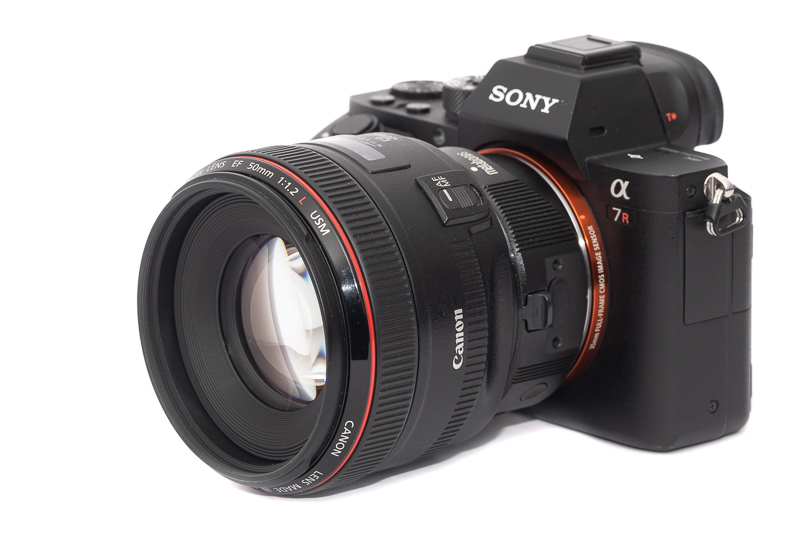
During the DSLR era the Nikon users always envied the Canon users for their fast f/1.2 primes – even though most would have never willingly admitted to that. But those f/1.2 primes came at a price not only quantified in hard earned dollars: autofocus inaccuracies and focus shift could really spoil the party.
Now the modern mirrorless cameras solved these issues, and when the first AF adapters for E-mount came out some people even said these lenses work better on Sony mirrorless cameras than they ever did on Canon (D)SLR cameras.
So let’s find out together in this review, if there is still a reason to get and use this lens in 2023.
Sample Images
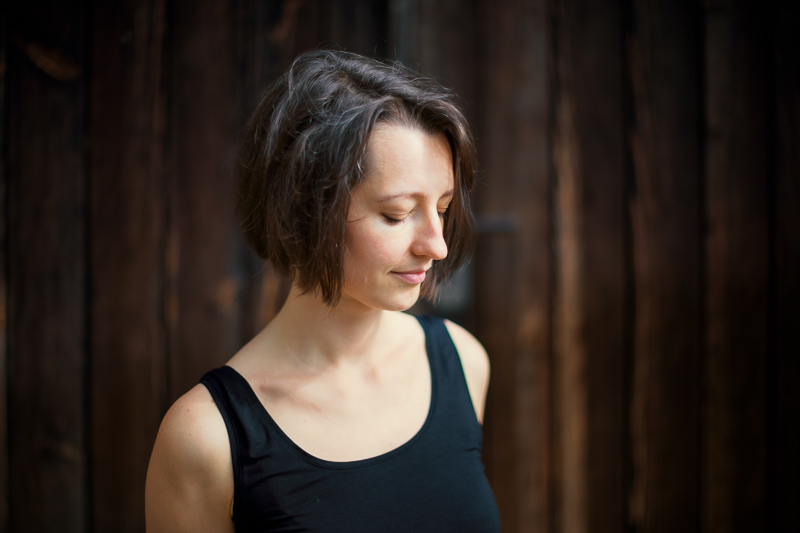


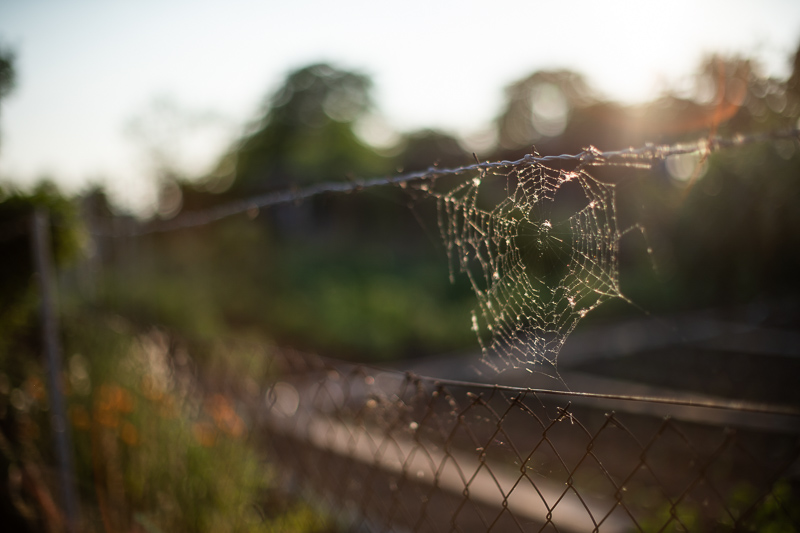
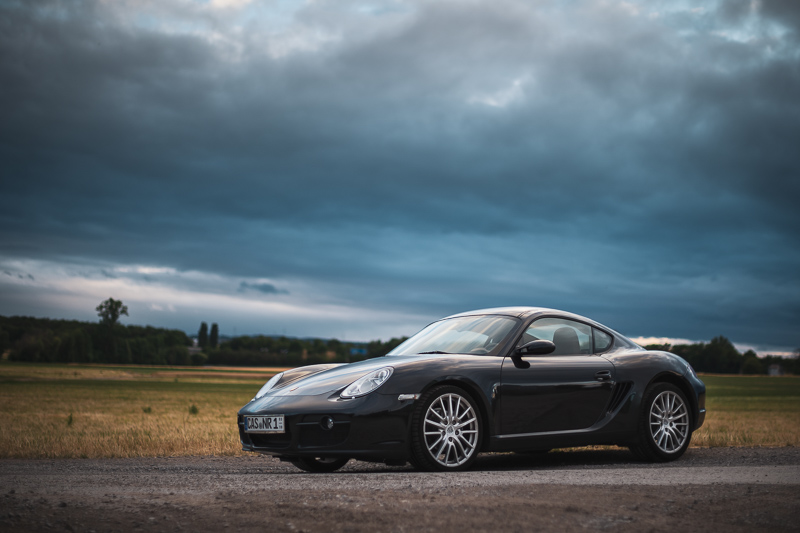
You can find most of the sample images in full resolution here.
Contents
Specifications / Version History
With the introduction of the EF-Mount in 1989 Canon also released a halo flagship 50mm lens: the Canon EF 50mm 1.0 L USM. For various reasons this has never been a mainstream lens and it took almost 20 years, until 2007, for Canon to add a more reasonable and more affordable 50mm lens to their high-end L-lineup: the Canon EF 50mm 1.2 L USM. Now what is very interesting: this lens is using a simple unit focus and not a floating elements design – unlike its predecessor the Canon FD 50mm 1.2 L. That is a bit of a strange decision for an expensive flagship 50mm lens.
This lens has the following specifications:
-
- Diameter: 86 mm
- Field of view: 46.6° (diagonally)
- Length: 66 mm + adapter
- Weight: 592g + adapter (without hood, without caps)
- Filter Diameter: 72 mm
- Number of Aperture Blades: 8 (rounded)
- Elements/Groups: 8/6

- Close Focusing Distance: 0.45 m
- Maximum Magnification: 1:6.5
- Released: January 2007
- Mount: Canon EF
buy from amazon.com | amazon.de | B&H | ebay.com | ebay.de (affiliate links) and the price is $1399 (new)
Disclosure
This Canon EF 50mm 1.2 L USM was kindly provided free of charge by one of our readers for reviewing purposes, thanks a lot!
Handling/Build quality
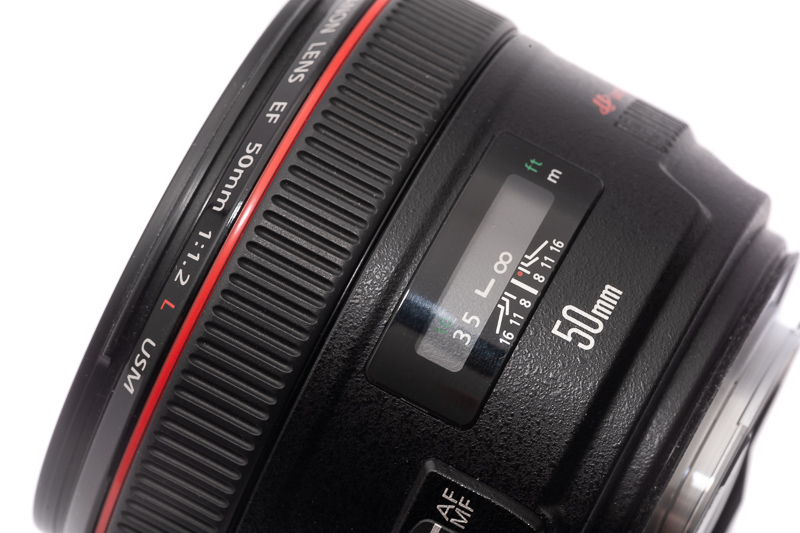
The Canon EF 50mm 1.2 L USM features the typical Canon L build quality, same as e.g. the Canon EF 135mm 2.0 L USM. The lens seems to be made from a mix of high quality polycarbonate and metal. The few marking seem to be only printed on though.
Unlike the Canon EF 85mm 1.2 L or the Canon EF 50mm 1.0 L this lens does not feature a focus-by-wire design. The focus ring is mechanically connected to the helicoid and it takes ~140° rotation from infinity to the minimum focus distance (0.45 m). Also unlike the other two Canon lenses this is just a simple unit focus design. The whole optical block moves visibly back and forth in the outer barrel.
On the side of the lens is a small AF/MF-switch.

There is an official bayonet-style hood (ES-78) available for this lens and it even has felt on the inside. It makes an already big lens pretty huge though.
On earlier samples of this lens the front retention ring may also come of when using the hood, either buy screwing it on too tightly or when bumping into something. More on that topic here.
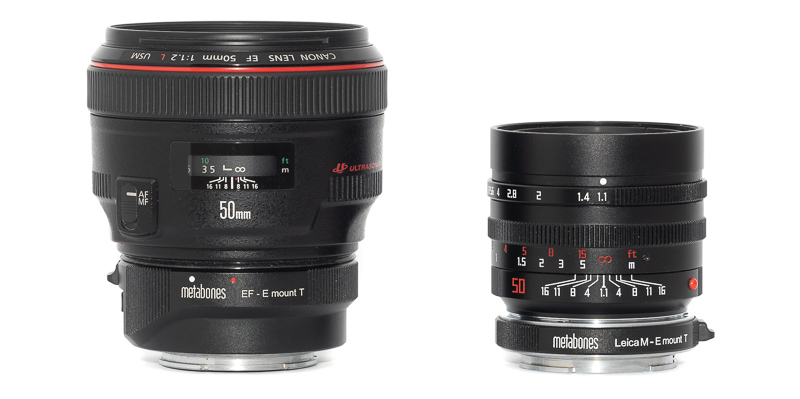
In lack of other comparable 50mm lenses I am showing you a size comparison to the Mr. Ding 50mm 1.1. Taking into account the adapter the Canon is similar in size to the Sony FE 85mm 1.4 GM.
I tried the lens with the Sigma MC-11 as well as the metabones MK IV and it worked well with both of them. I do prefer the metabones adapter because in its advanced mode it allows for focusing with working aperture to get rid of the focus shift.
Vignetting
light falloff
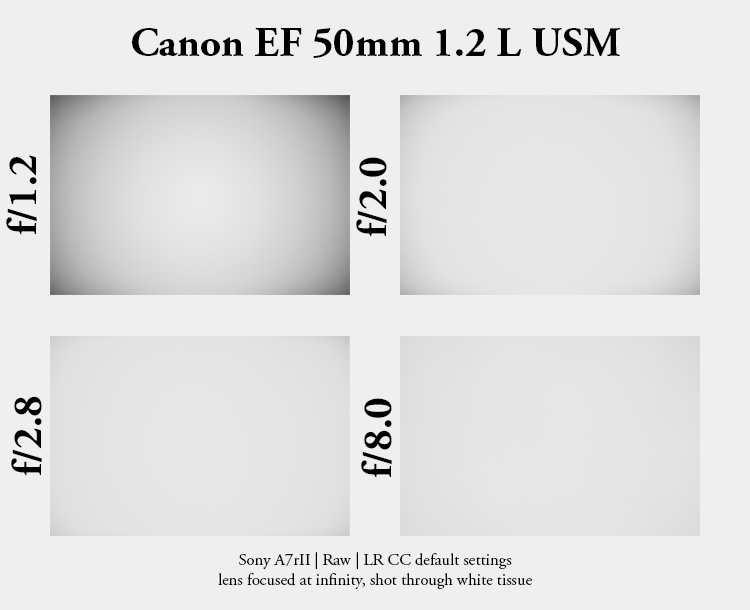
| f/1.2 | 3.1 EV |
| f/1.4 | 2.7 EV |
| f/2.0 | 1.7 EV |
| f/2.8 | 1.0 EV |
| f/4.0 | 0.6 EV |
| f/5.6 | 0.5 EV |
| f/8.0 | 0.5 EV |
| f/11-f/16 | 0.4 EV |
The Canon EF 50mm 1.2 L USM is a big lens, but the diameter of the lens elements is in fact not nearly as big as the outer dimensions of the casing suggest. At wider apertures the vignetting is about half a stop higher compared to the Samyang 50mm 1.2 XP or the Meike 50mm 1.2 (both available for EF mount as well) and also higher than those of the compact Voigtländer 50mm 1.2 E.
The good news is that by f/2.0 the vignetting is already greatly reduced.
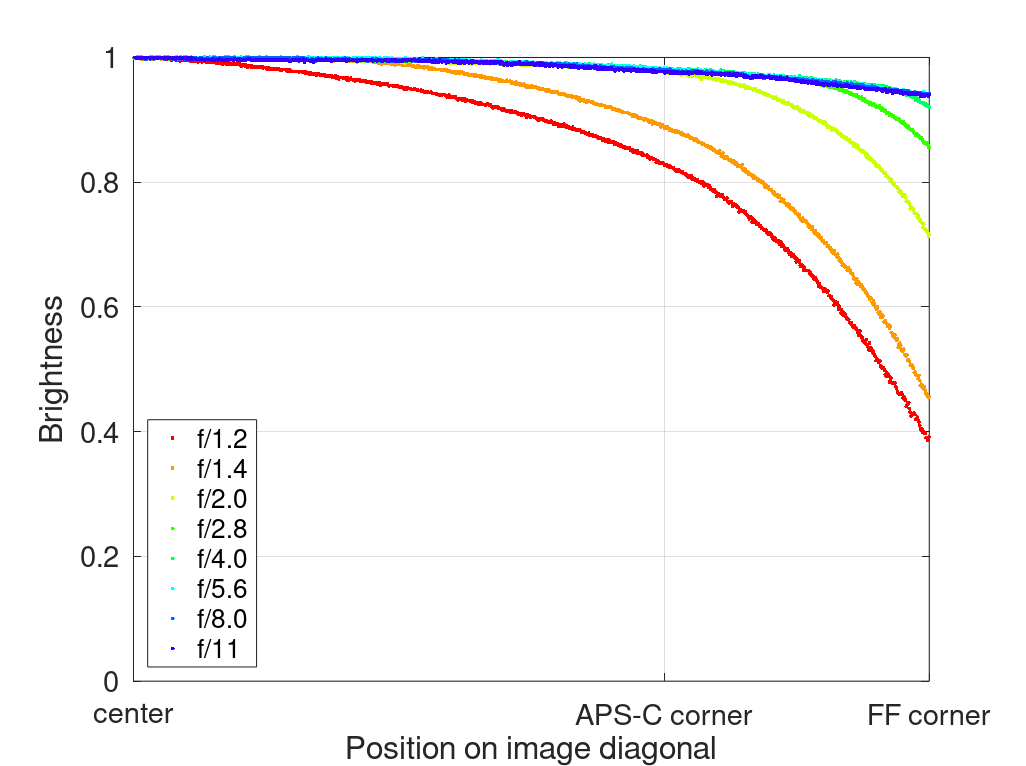
It is recommended to have a look at this article first to get an idea how this brightness graph works.
optical vignetting
Fast lenses usually show a noticeable amount of optical vignetting. Without going too much into technical details optical vignetting leads to the truncation of light circles towards the borders of the frame.
In the center of the frame almost every lens will render a perfect circle, but only lenses with very low optical vignetting will keep this shape in the corners.
So in the following comparison we move from the center (left) to the extreme corner (right) and see how the shape of the light circle changes.
I did not shoot the lenses side by side, if I did the light circles would be of same size at shared apertures. The lenses were set to 0.7 m focus distance, results may vary at other distances.
The Canon lens actually performs very similar to the Samyang 50mm 1.2 XP. At wider apertures there is a lot of optical vignetting and light circles close to the corners are also truncated by the adapter (mechanical vignetting). The Sigma MC-11 (this is the one I used here) cuts the highlights a little less than the metabones MK IV.
What surprised me a great deal: there are absolutely no onion rings visible. This cannot be said about the Meike 50mm 1.2, that also shows higher optical vignetting than the other two.
Sharpness
Focus shift
The Canon EF 50mm 1.2 L USM does show focus shift and it is enough for the subject not to be in the focal plane anymore, especially on stopping down to f/2.8.
With the later metabones EF->E adapters you can use this lens in its “advanced” mode and it will behave like a native Sony lens with stopped down metering and AF, getting rid of any focus shift issues completely.
infinity (42mp Sony A7rII)
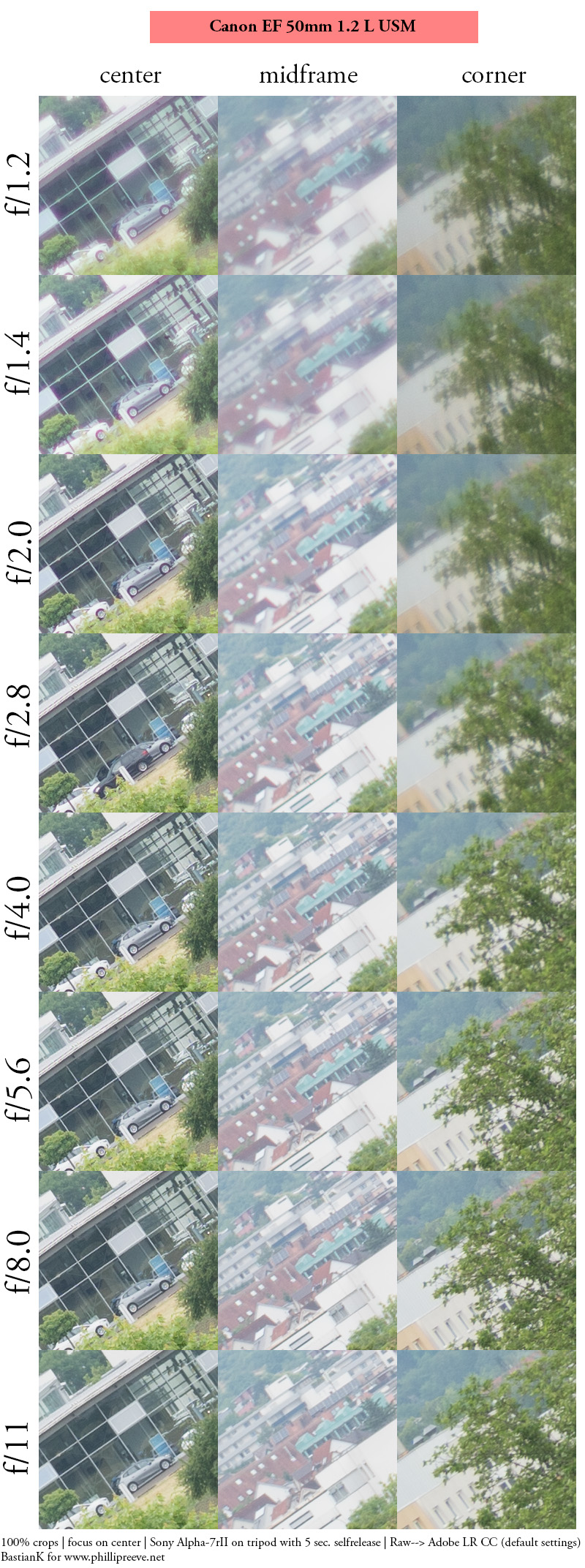
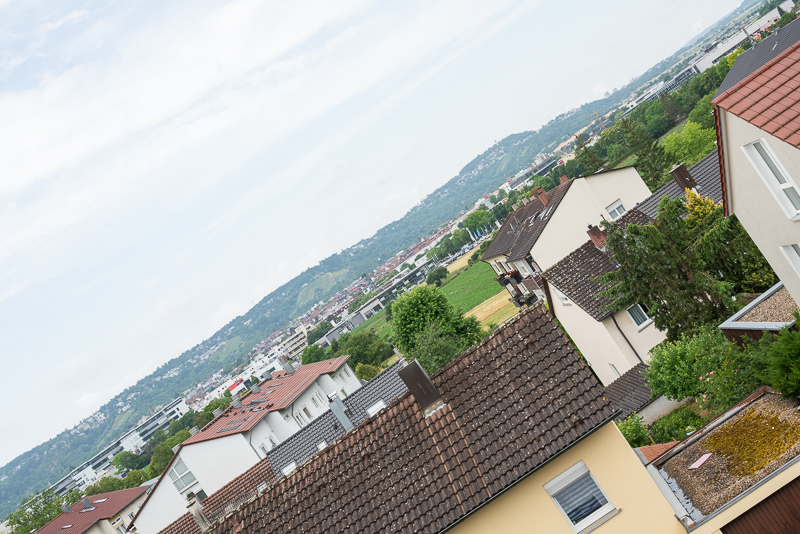
This Canon EF 50mm 1.2 L USM is not perfectly centered (I also wouldn’t expect that of a 16 year old 50mm f/1.2 lens) and I am showing you the better corner here.
As I told you before this is a unit focus lens and unit focus lenses can only be optimized for a certain focus distance and looking at these results I don’t think that distance had been infinity.
At f/1.2 to f/1.4 this lens is seriously soft. Not only softer than the more complex Samyang 50mm 1.2 XP, but also softer than the much cheaper Meike 50mm 1.2 (both lenses featuring a floating elements design by the way). Actually at these aperture values the performance is similar to the 60 years old Canon 50mm 1.2 LTM.
By f/4.0 most of the frame looks really good and by f/8.0 to f/11 also the corners hardly leave anything to be desired.
Comparing this lens to the latest f/1.2 lenses also shows how far we have come. The Sigma 35mm 1.2 Art DG DN as well as the Sony FE 50mm 1.2 GM and of course also the Canon RF 50mm 1.2 L show much better performance at wider apertures – at all distances.
portrait distance (1.4 m)
Now obviously the main application for a 50mm lens as fast as f/1.2 is for portraiture and I would also expect this lens to have been optimized for these distances, so let’s see how it fares at a typical portrait distance of 1.4 m.
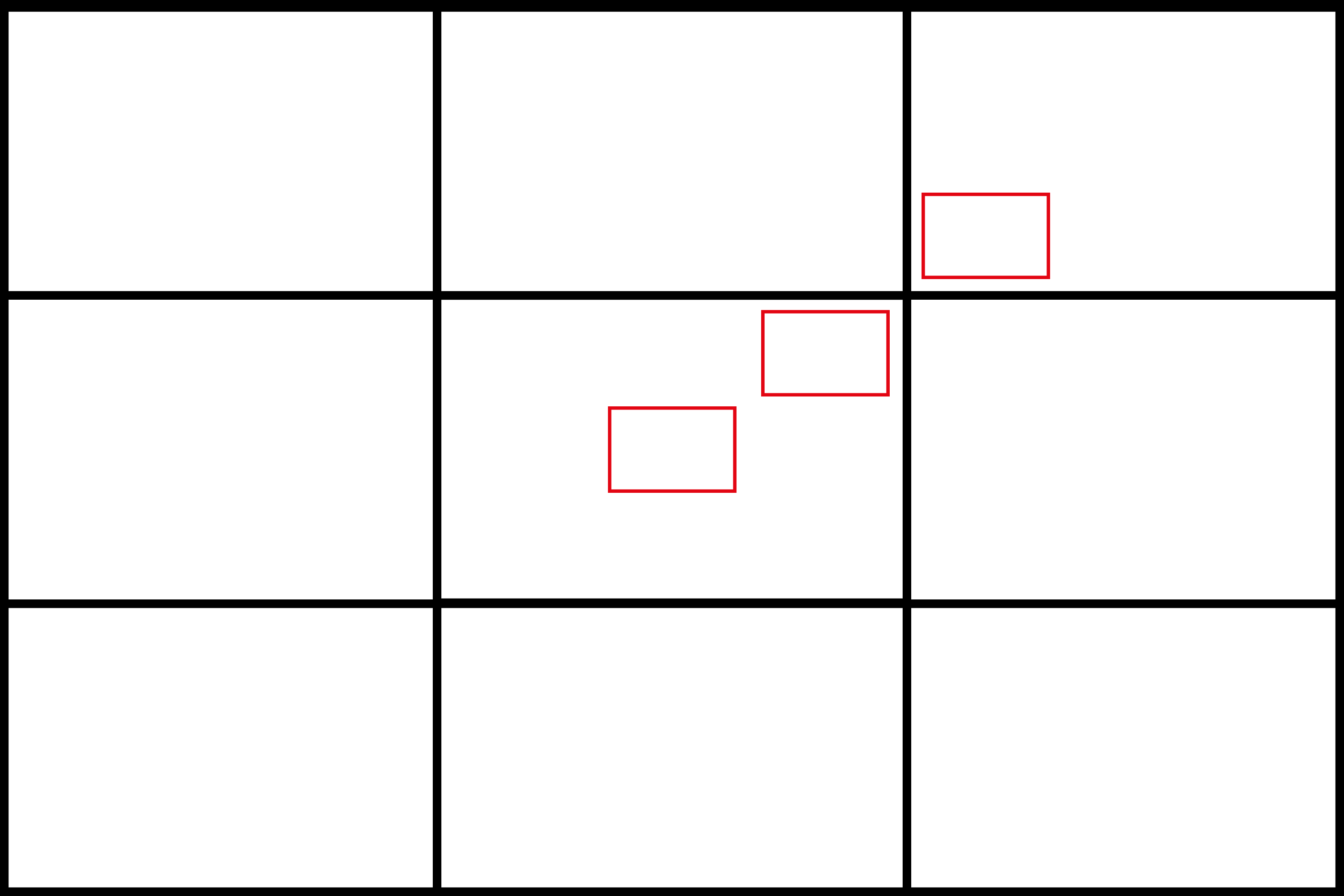
I refocused for every shot and aperture to get the best possible result at different locations in the frame (center, inner midframe and outer midframe).
The circle of the dollar bill is more or less the size of a human eye.
f/1.2 <—> f/2.0
The contrast isn’t record breaking high at f/1.2 but it is possible to get good enough performance for portraits at focus point even in the outer midframe area.
The performance here is similar to the Meike 50mm 1.2. Now the Samyang 50mm 1.2 XP with its more complex optical design has way higher contrast and resolution at f/1.2, but in the outer midframe it wasn’t as easy to focus due to some astigmatism.
close (0.45 m, 1:6.5)
100% crops from center, A7rII, because of focus shift (see corresponding section) I refocused for every shot.
Now here is something that really leaves me wondering. The predecessor, the 27 years older Canon FD 50mm 1.2 L, made use of a floating elements design. The 18 years older halo Canon EF 50mm 1.0 L made use of a floating elements design. The 18 years older Canon EF 85mm 1.2 L also made use of a floating elements design. This lens doesn’t and it is really obvious because the performance at its minimum focus distance is all but great at wider apertures.
What also doesn’t help: contrast and resolution do not peak in the same focal plane, therefore the f/1.4 crop has lower contrast but more resolution than the f/1.2 one.
The Samyang 50mm 1.2 XP focuses just as close but performs way better. To match the Samyang’s performance at f/1.2 the Canon needs to be stopped down to something between f/2.0 and f/2.8.
While the Meike 50mm 1.2 doesn’t focus as close, it still shows a better performance and even Meike thought of adding a floating elements design.
Flare resistance
As always evaluating flare is a complex matter since you can get any lens to look bad if you push it hard enough and a slight change of scenario can affect results a lot.
That being said this is a very fast lens with big glass elements first released in 2007 so I don’t expect a great performance here. But maybe we will all be positively surprised.
With a strong light source close to the very corner of the frame a big flare can be created, this is the case for most lenses actually. With the sun somewhere in the frame all kinds of artefacts can be created:
At f/1.2 even a ring flare can be created, it disappears on stopping down to f/2.4:
Stopped down to f/11 the performance doesn’t actually improve, sometimes the artefacts are even bigger and more distracting:
I tried to fabricate a scenario where the hood helps, but I did not manage to do that, meaning the hood doesn’t really make a difference.
The Samyang 50mm 1.2 XP also didn’t perform great in this category, but still a bit better. The best performer is the Voigtländer 50mm 1.2 Nokton E, it is very rarely to encounter any unwanted artefacts with that lens.
We should also keep in mind this is a lens that will primarily be used for portraiture and some people like to have lens flares in their pictures here.
Coma
100% crops from extreme corner, Sony A7rII
This is another category where the Canon cannot keep up with the latest high performance f/1.2 lenses like the Sony FE 50mm 1.2 GM or Sigma 35mm 1.2 Art DG DN. When I reviewed the Samyang 50mm 1.2 XP I wasn’t too impressed by its coma correction, but it is still a lot better than what we see here.
The artefacts not being symmetrical might be another sign of this lens not being perfectly centered.
Distortion
Sony A7III | Canon EF 50mm 1.2 L USM | f/8.0
The Canon EF 50mm 1.2 L USM shows a low amount of barrel distortion. A correction profile is available in Lightroom/ACR that does a very good job at correcting it.
Bokeh

We talked about focus shift, vignetting, sharpness, distortion and coma. But does any of that really matter for a 50mm f/1.2 portrait lens? Not neccessarily. My all time favorite portrait lens is the Sony FE 85mm 1.4 GM, disregarded by many people for “lacking sharpness” at f/1.4. An argument I can barely take serious. So let’s see how the Canon EF 50mm 1.2 L USM fares in its prime category.
From this comparison we see two things: contrast and sharpness are pretty good even with the focus point off center, but at f/1.2 and f/1.4 the bokeh can only be described as busy.
Stopped down to f/2.8 the bokeh is a lot calmer, but still not as smooth as the latest 50mm lenses optimized not only for sharpness but also out of focus rendering.
In this scene the rendering at f/1.2 actually reminds me a lot of the MS-Optics 50mm 1.0 when stopped down to f/1.4. The difference between f/1.2 and f/2.0 is really big, not only in terms of quantity but also quality.
Let us now check how the lens performs at different distances.

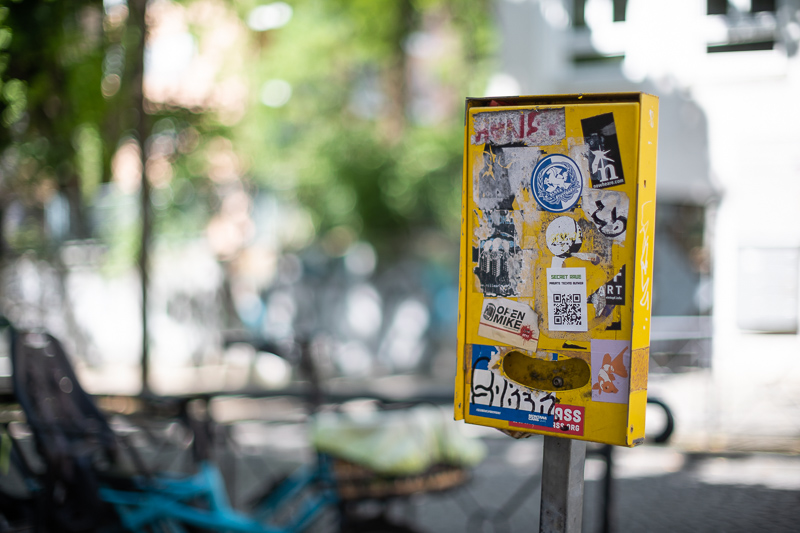
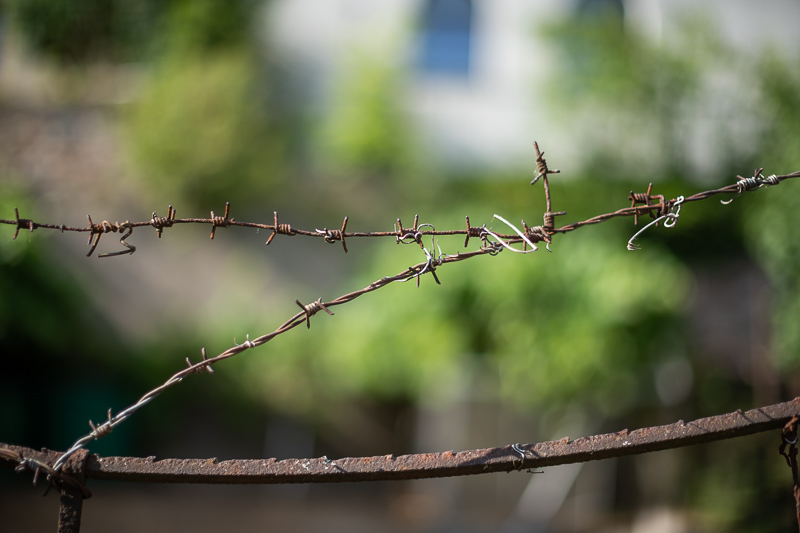

Even at short focus distances complex backgrounds can look a bit messy and distracting and already here stopping down to f/2.0 makes a big difference.

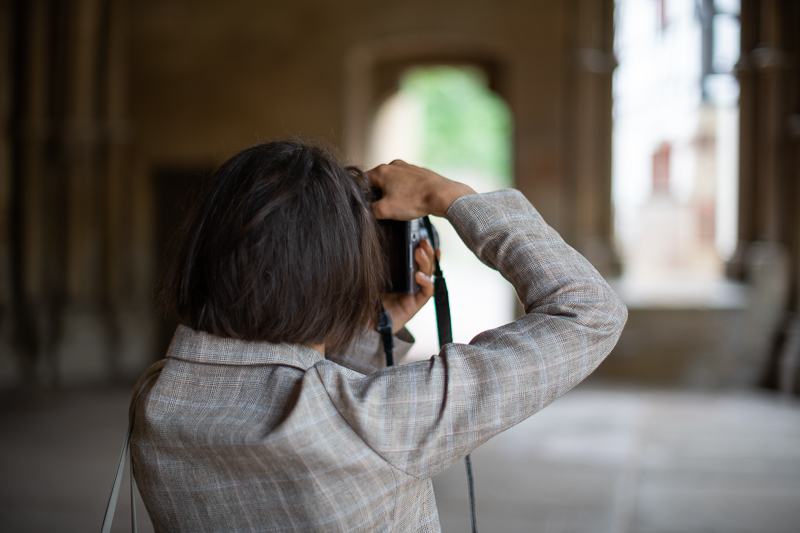
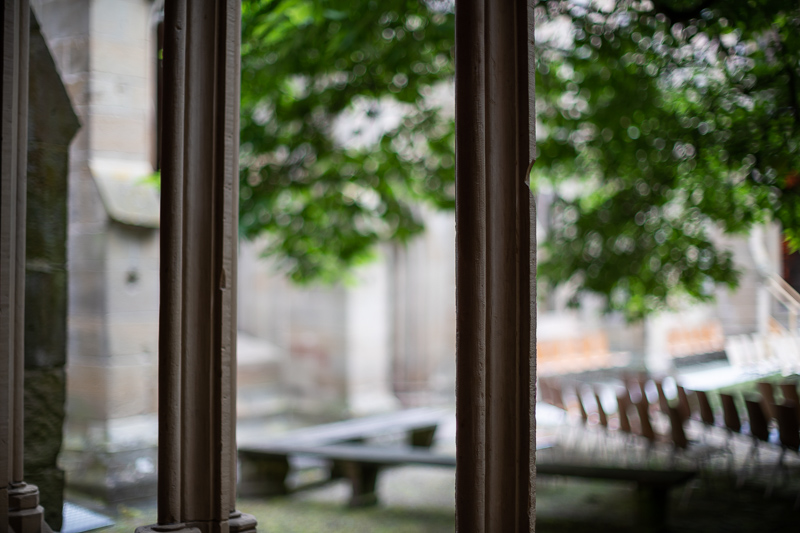
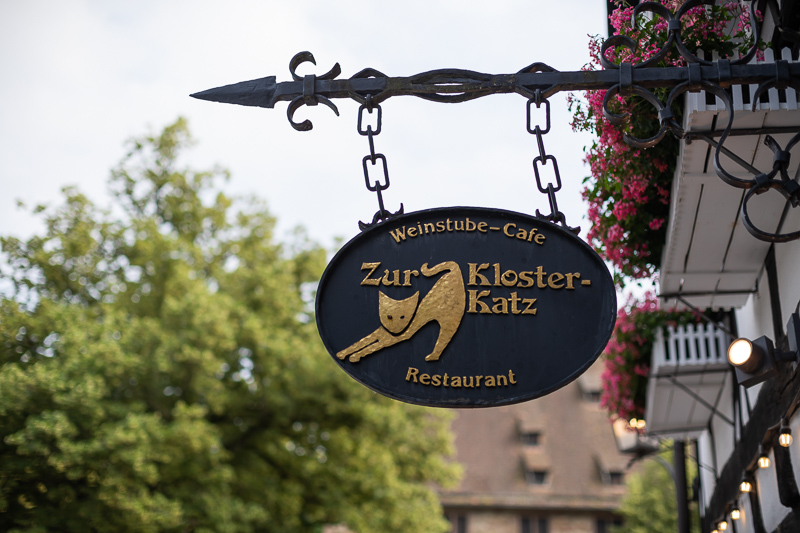
At mid distances foliage and other complex backgrounds can become really distracting thanks to double edged structures.
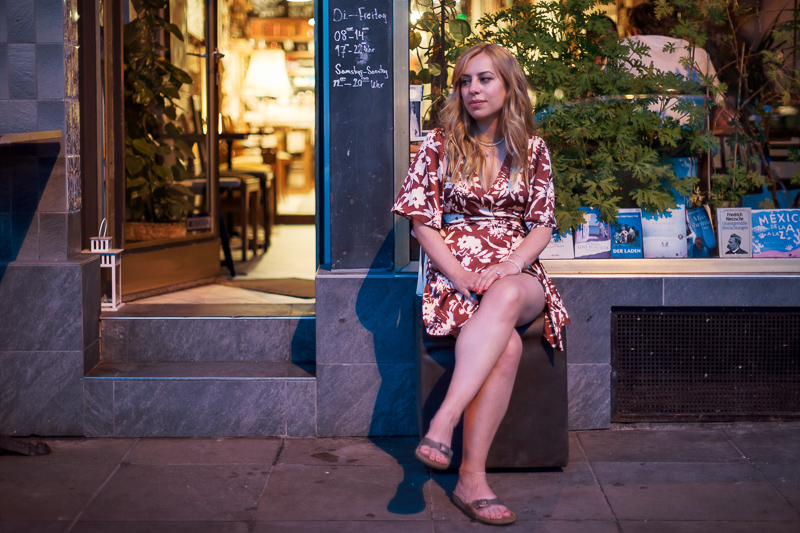
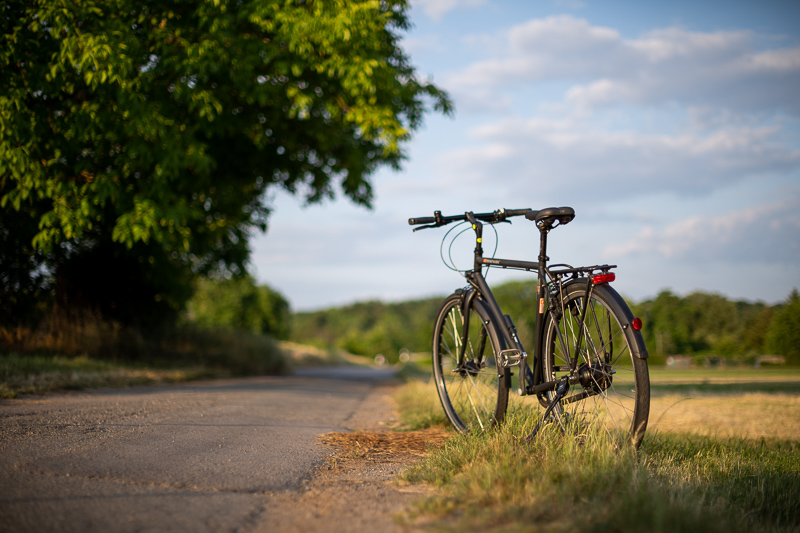
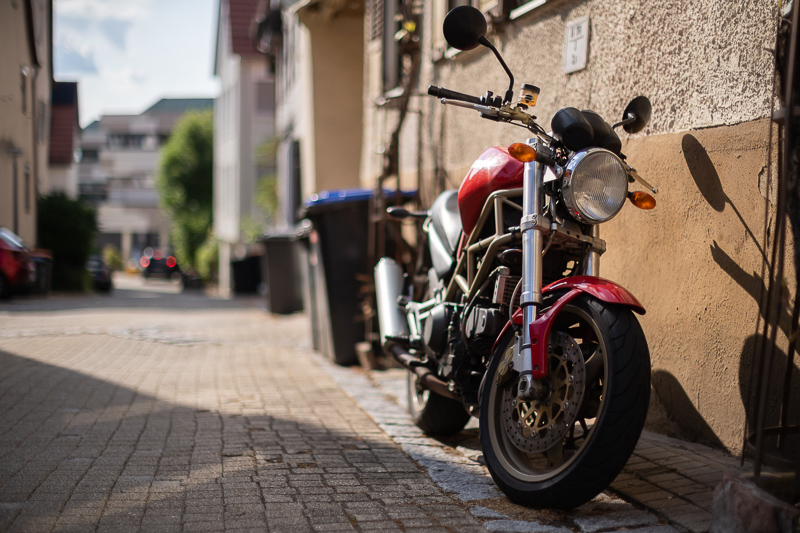
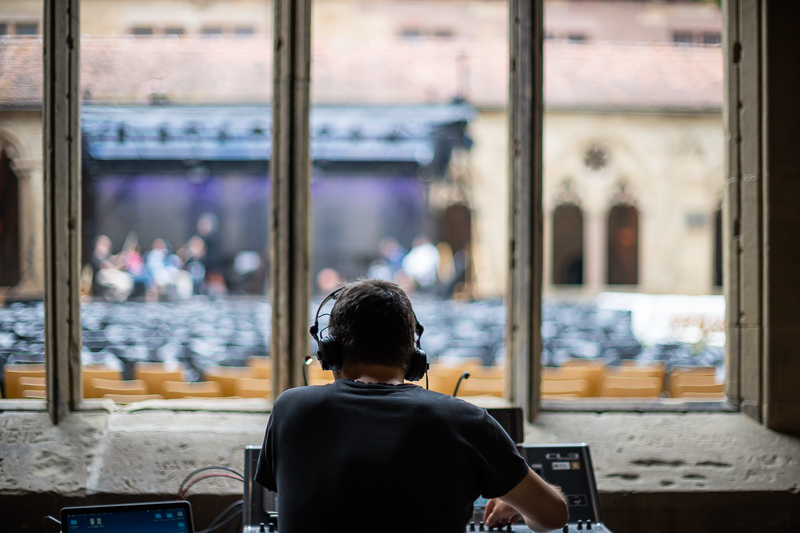
I think the last sample is a real worst case scenario and a prime example for bad bokeh. The background is so distracting that it is hard to keep the eyes on the actual subject.
After having used this lens for some time I get the strong feeling it has been optimized for good sharpness at f/1.2 and not so much smooth or undistracting bokeh rendering.
In comparison I think the Samyang 50mm 1.2 XP draws a much nicer bokeh at f/1.2 – without autofocus of course.
This is a subjective topic though and I am sure there are people who really like the bokeh from this lens, so best have a look at the sample images provided and decide for yourself if you like what you see here.
Sunstars
I always considered Canon’s choice of 8 rounded aperture blades a good compromise between appealing out of focus rendering stopped down a bit and nice sunstars stopped further.
Here you can see why, stopped down to f/8.0 to f/16 we get very appealing sunstars without ruining the bokeh stopped down to f/2.8 to f/4.0. If you want to learn more about this topic have a look at this article.
Chromatic aberration
lateral
100% crops from corner, A7III
Lateral CA are on a low to medium level and easily corrected with one click in Lightroom.
longitudinal
The Canon EF 50mm 1.2 L USM shows a high amount of longitudinal CA at wider apertures which isn’t really surprising for an f/1.2 lens released in 2007. As can be seen from the following pictures, stopping down to f/2.0 is not sufficient to fully getting rid of this aberration:
Purple fringing can also be an issue in high contrast scenes:
The performance of the Canon EF 50mm 1.2 L USM is about as good as we can expect from an f/1.2 lens of its era. It took until the latest generation of way more complex f/1.2 lenses like the Sigma 35mm 1.2 Art DG DN to show a noticeable improvement in this category.

Conclusion
good
|
average
|
not good
|
In the DSLR era generations of Nikon users have lusted after Canon’s two f/1.2 lenses with AF, one of them being this Canon EF 50mm 1.2 L USM, but a lot has happened since this lens had been released in 2007.
Compared to the latest f/1.2 lenses like the Sony FE 50mm 1.2 GM, the Sigma 35mm 1.2 Art DG DN, Laowa 28mm 1.2 Argus or even the Samyang 50mm 1.2 XP this Canon has a very simple optical design and this also translates to its optical performance: CAs are high, coma is strong and the flare resistance leaves some to be desired. Not featuring a floating elements design, this Canon lens also performs best at portrait distances at wider apertures.
And I really wonder why Canon did not use a floating elements design for this lens (they did for its predecessor the Canon FD 50mm 1.2 L as well as the Canon EF 85mm 1.2 L USM I/II).
One of the main issues for (D)SLR users was the focus shift though. Something the phase detect AF of these cameras could not account for and that could really spoil the game. With mirrorless cameras this can be accounted for, at least when using the lens with a metabones adapter in advanced mode on a Sony camera.
Now in 2023 you don’t buy an f/1.2 lens for slightly faster shutter speeds – as it was neccessary with analogue cameras – you buy it for the look it gives your pictures. And here the Canon lens is definitely not like the aforementioned modern lenses. The bokeh shows a lot of outlining at f/1.2 to f/1.4, which leads to busy and distracting backround rendering, at least to my eyes.
The situation is very different from f/2.0 onwards though, where it is a lot smoother.
But then some people may really like this combination of speed, AF and busier bokeh and it is not like there are a lot alternatives available. If this is the case for you, I would recommend to look for a used sample though, new this lens is way too expensive.
buy from amazon.com | amazon.de | B&H | ebay.com | ebay.de (affiliate links) and the price is $1399 (new)
Alternatives
Just lately we put together a rather comprehensive guide on 50mm lenses for Sony FE cameras which should give you a good overview, therefore I will only talk about the most obvious alternatives here:
Sony FE 50mm 1.2 GM:
This might be the gold standard when it comes to 50mm f/1.2 lenses these days. Not only is it doing a better job at combining high resolution with appealing bokeh, it is also smaller and lighter than its current competitors, the Canon RF 50mm 1.2 L and the Nikon Z 50mm 1.2 S.
Compared to this older Canon EF 50mm 1.2 L you can clearly see 15 years of technical advance. The Canon lens reviewed here is much softer at f/1.2 and generally doesn’t correct most optical aberrations as well.
buy from Amazon.com | B&H | ebay.com (affiliate links) for $1999
Voigtlander 50mm 1.2 Nokton E:
If you want a more compact 50mm 1.2 and you don’t necessarily need AF this is your lens. It offers very smooth bokeh rendering and has only a few minor flaws, by which I mean that it is also not very sharp at closer distances and a bit softer at f/1.2, similar to this Canon lens actually.
buy from CameraQuest | B&H | Robert White | amazon.com | amazon.de | ebay.com | ebay.de for $799 (affiliate links)
Sample Images



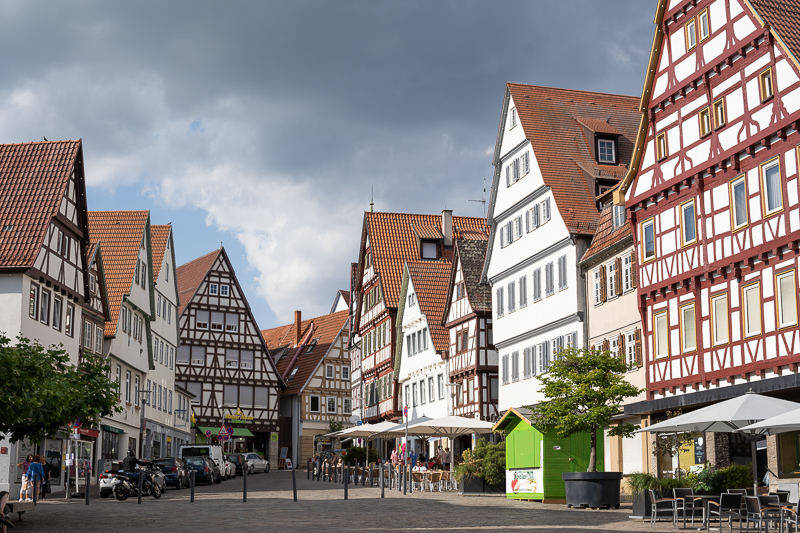
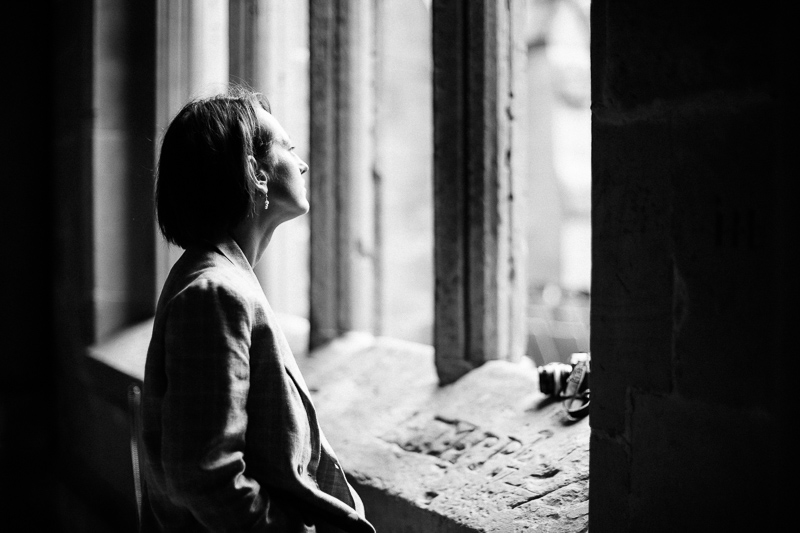
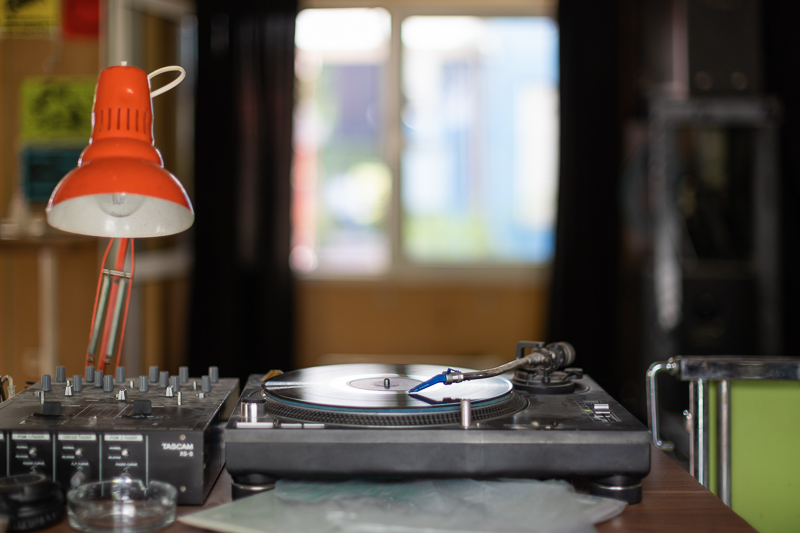
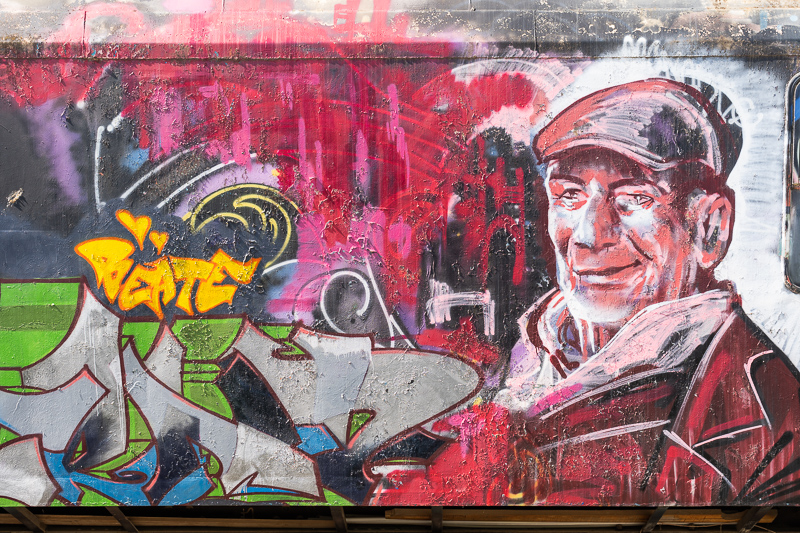
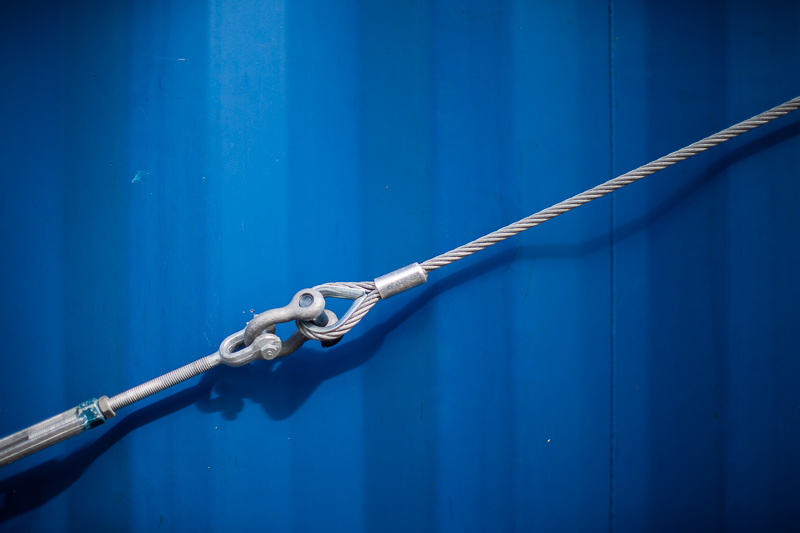
You can find most of the sample images in full resolution here.
Further Reading
Support Us
Did you find this article useful or just liked reading it? Treat us to a coffee!
![]()
![]()
![]() via Paypal
via Paypal
This site contains affiliate links. If you make a purchase using any of the links marked as affiliate links, I may receive a small commission at no additional cost to you. This helps support the creation of future content.
Latest posts by BastianK (see all)
- Analogue Adventures – Part 33: Harman Phoenix 200 - July 24, 2024
- Review: Nikon 200mm 2.0 IF-ED Ai – The first of its Kind - July 21, 2024
- Review: Voigtländer 50mm 1.1 Nokton – Better than its reputation? - July 17, 2024








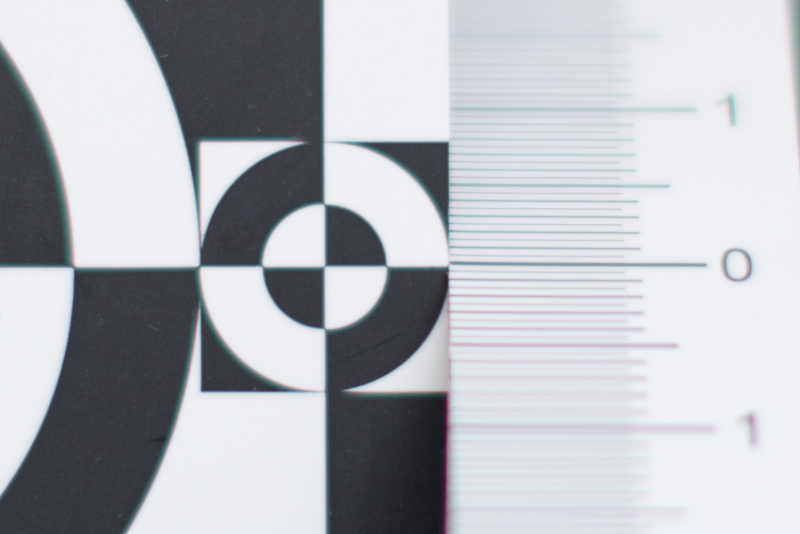


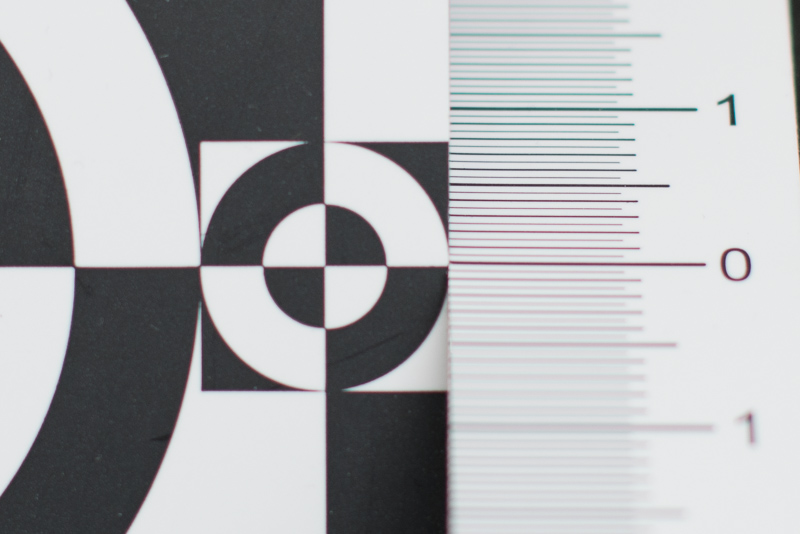
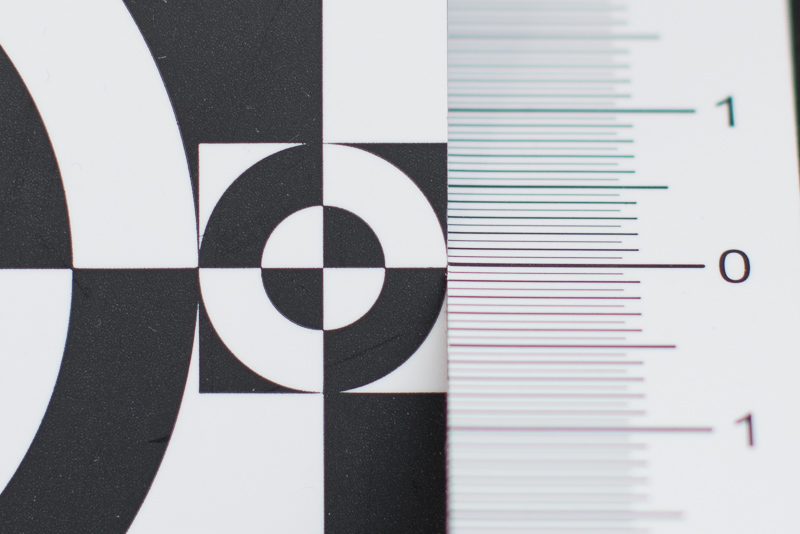

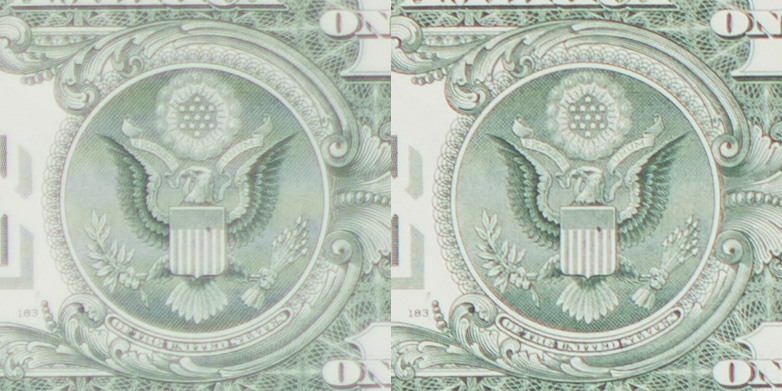
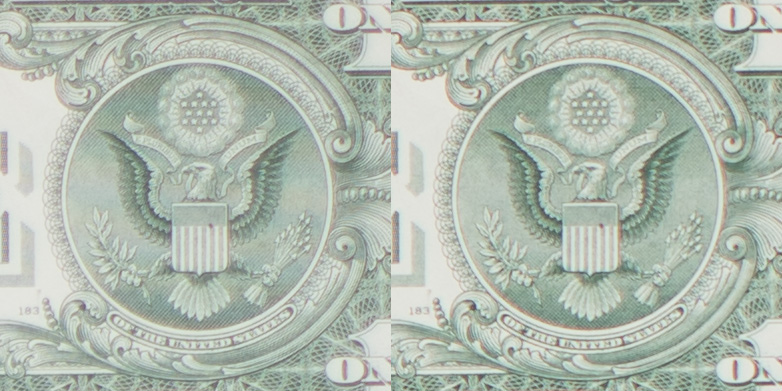
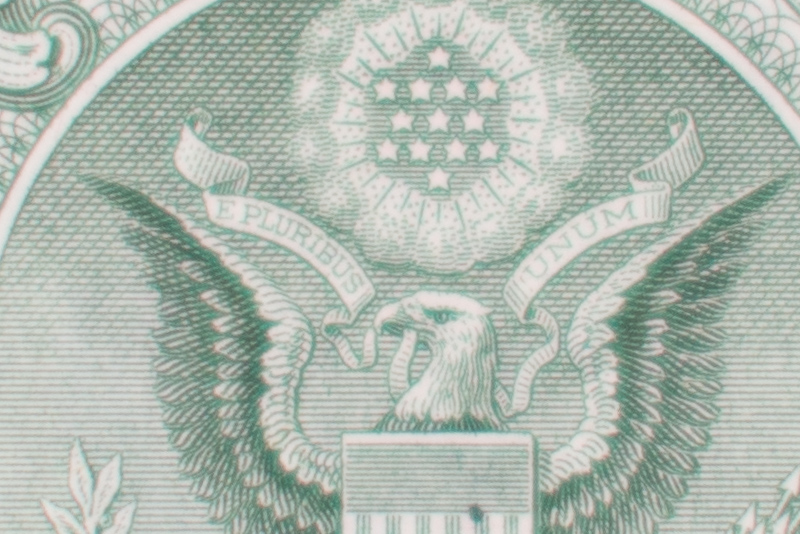
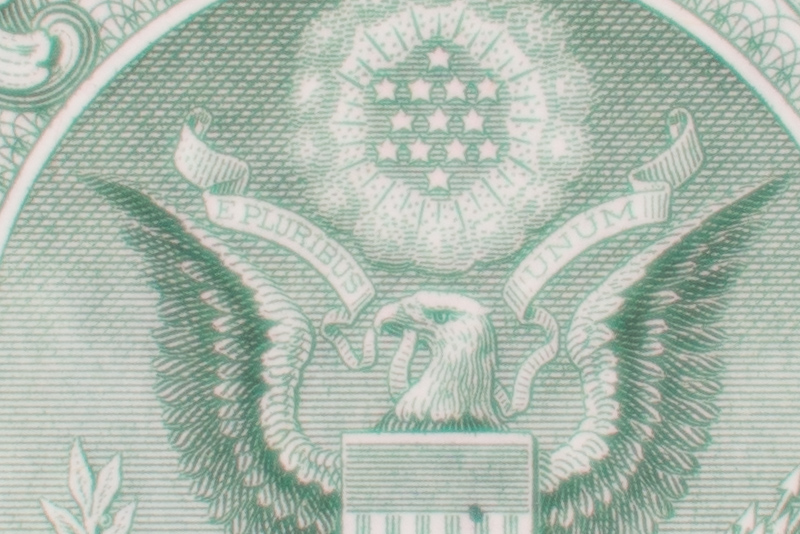
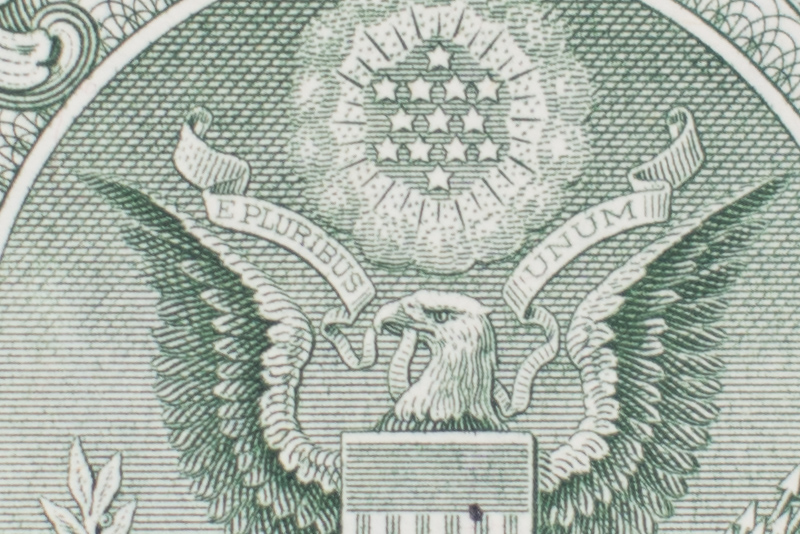
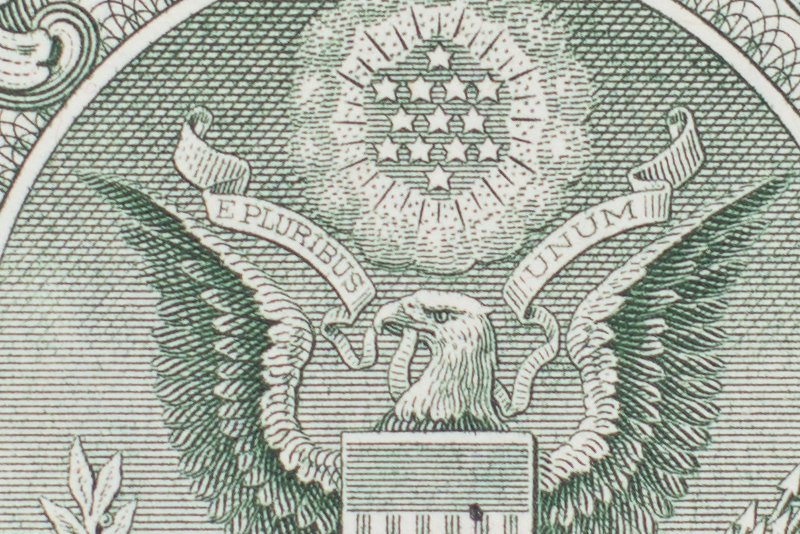
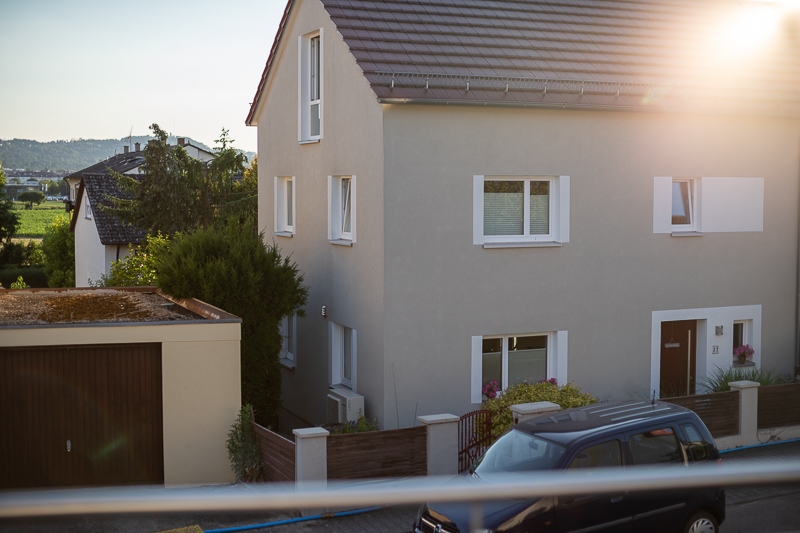
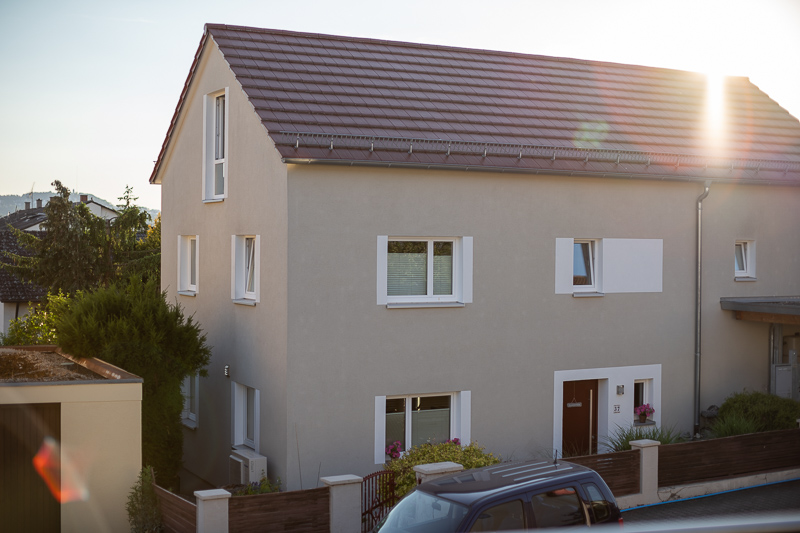
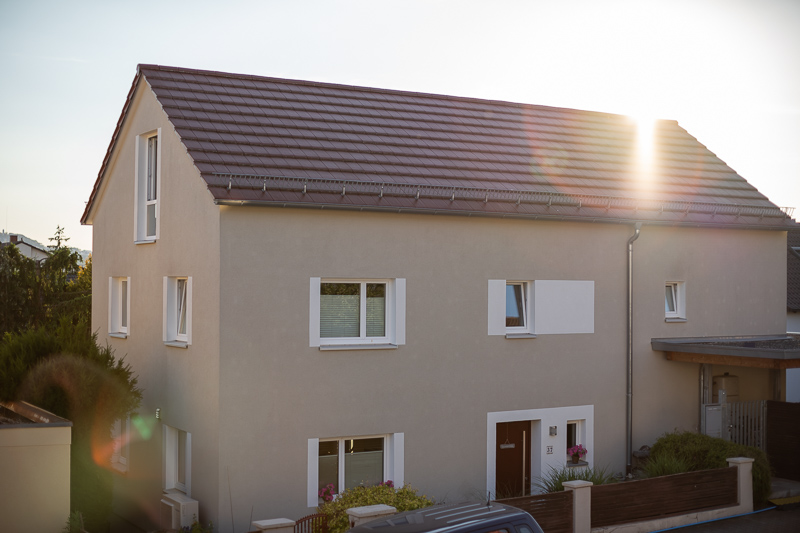

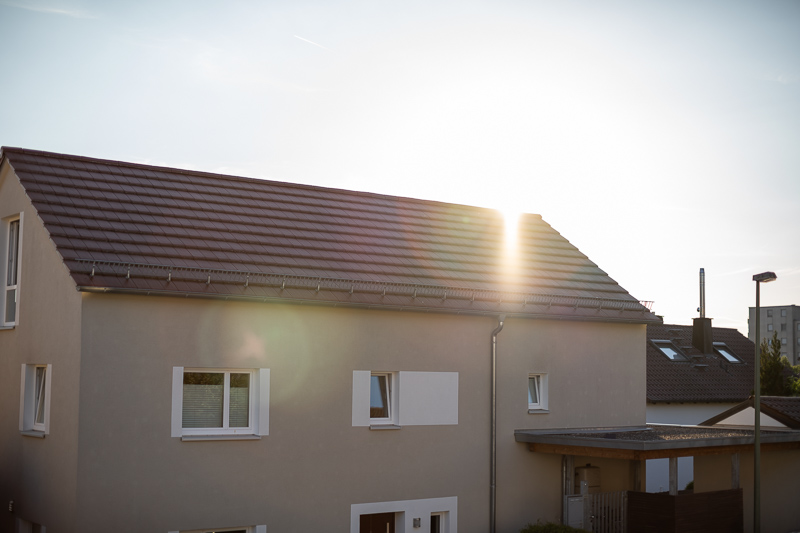
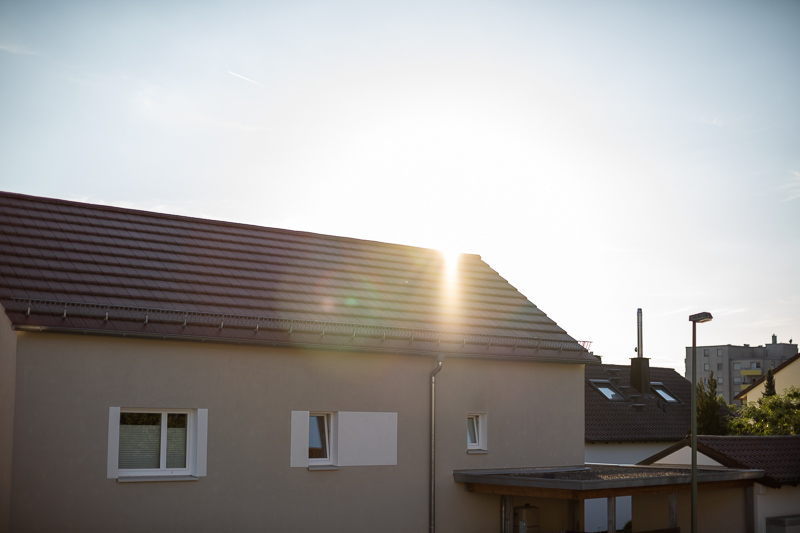
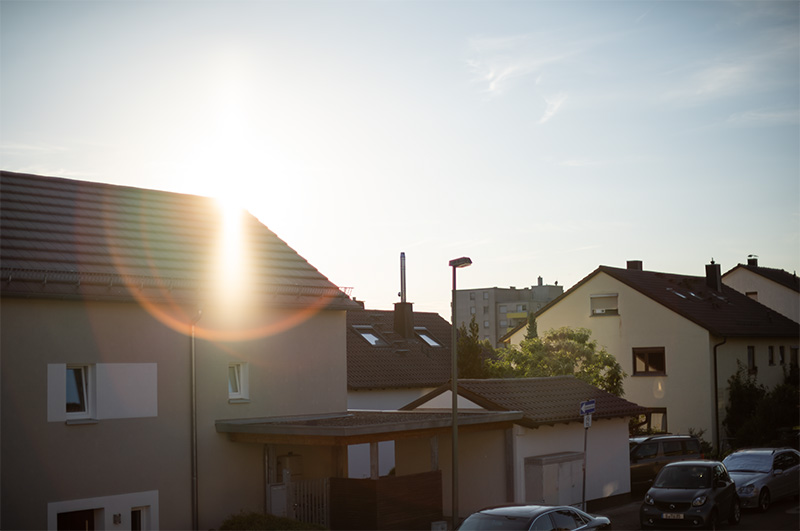
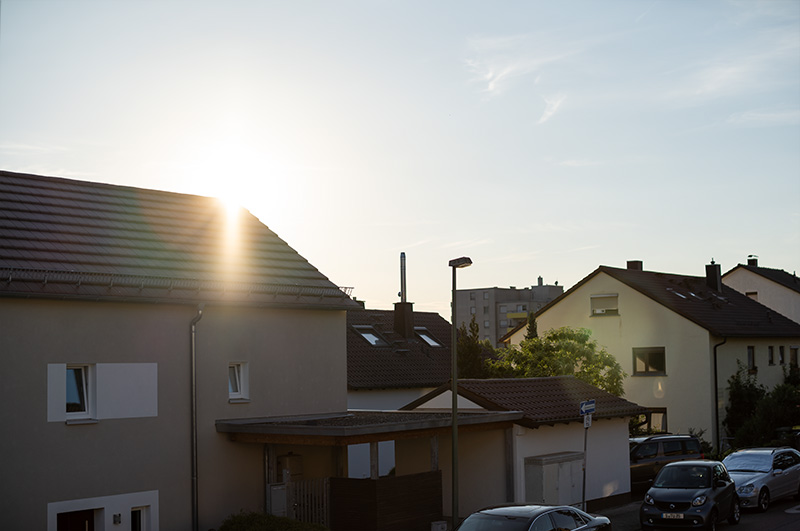

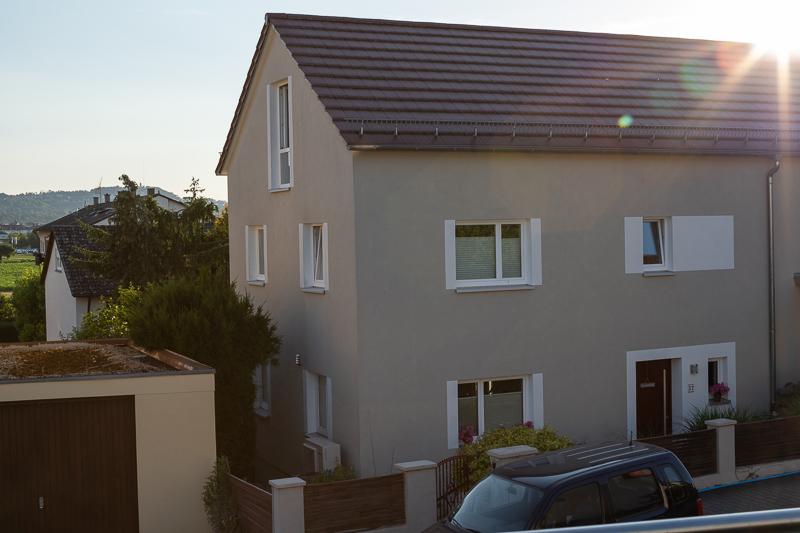
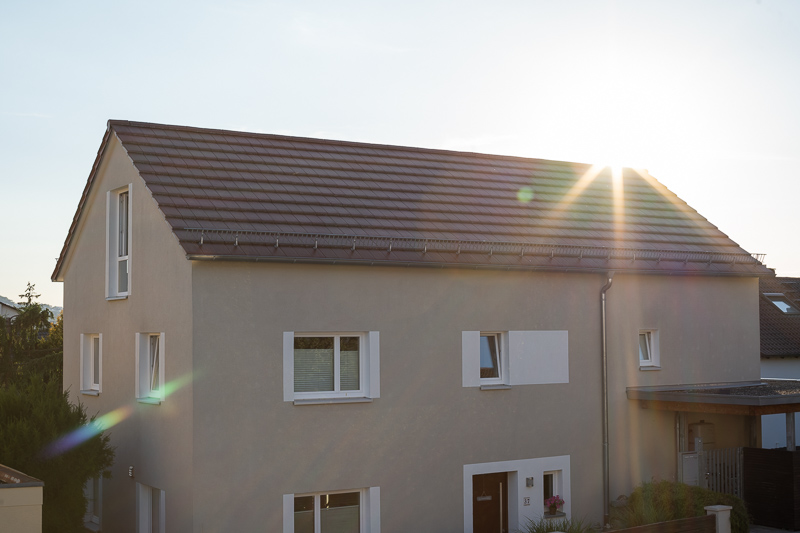

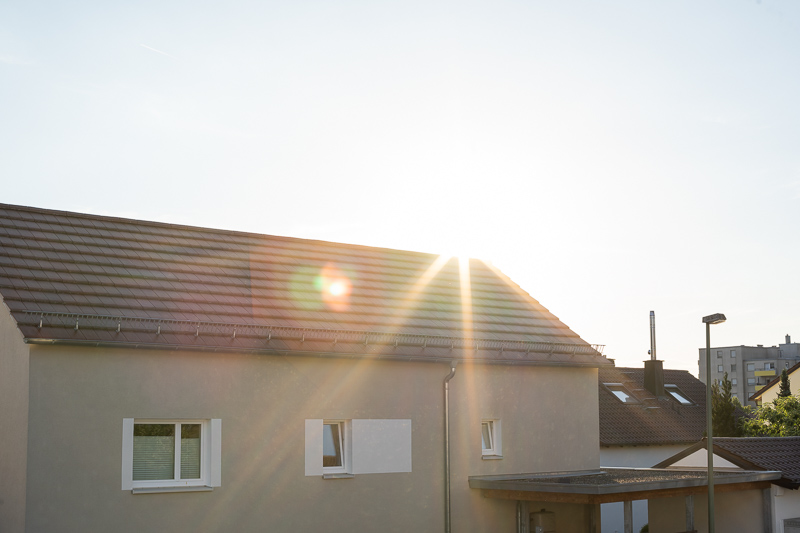
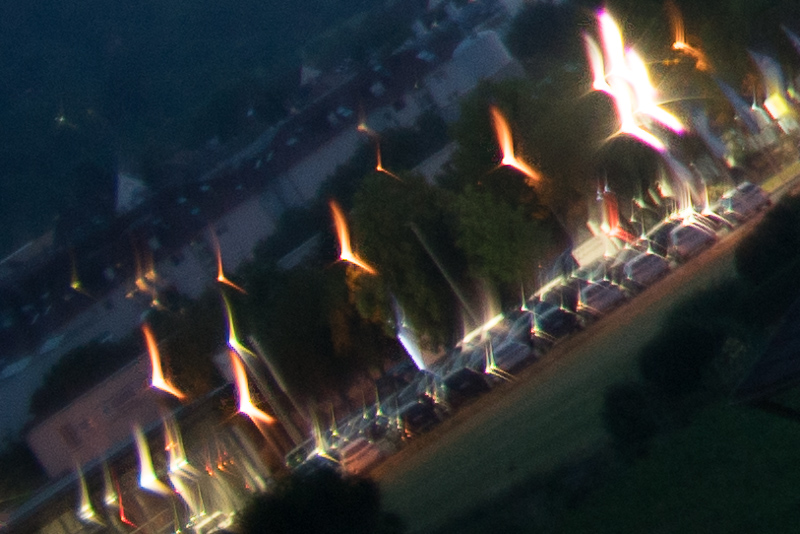

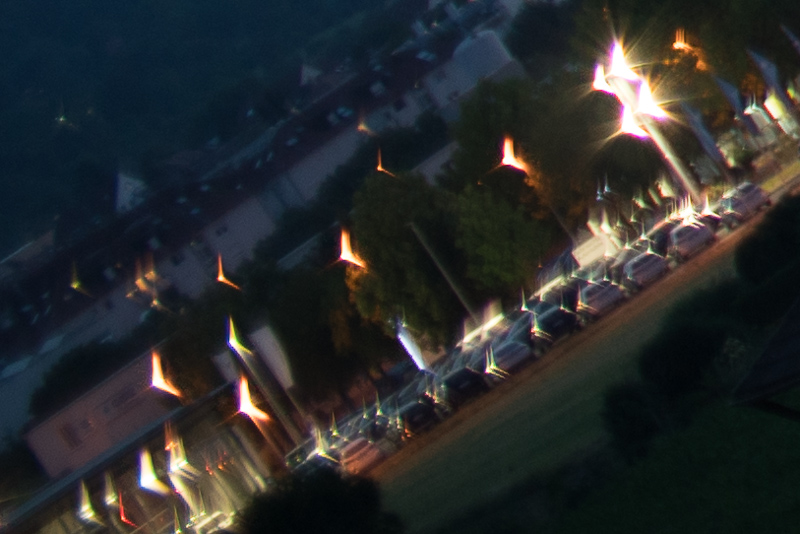

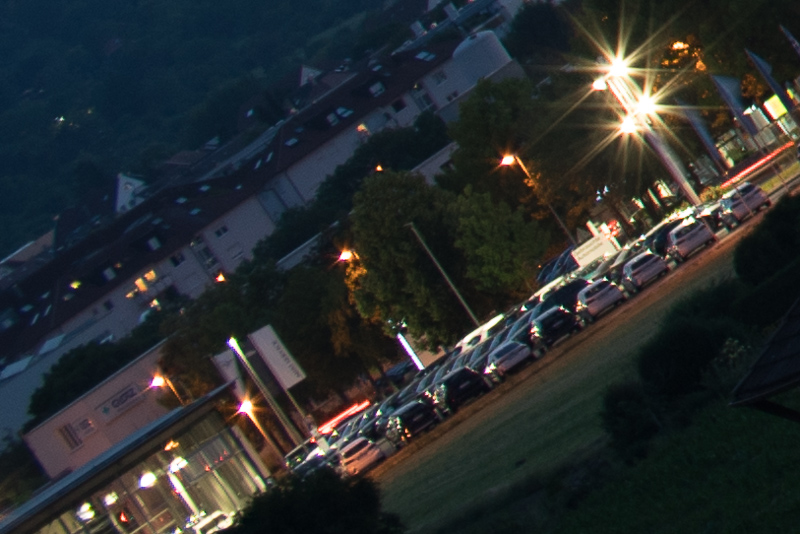
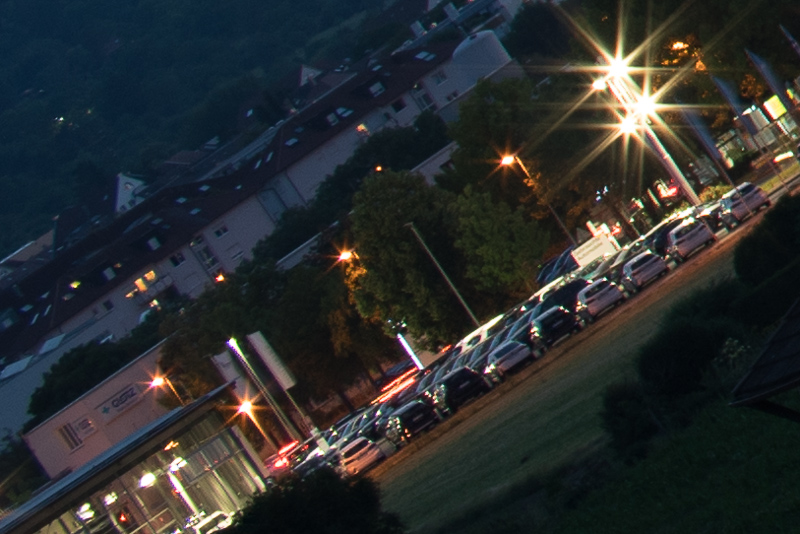
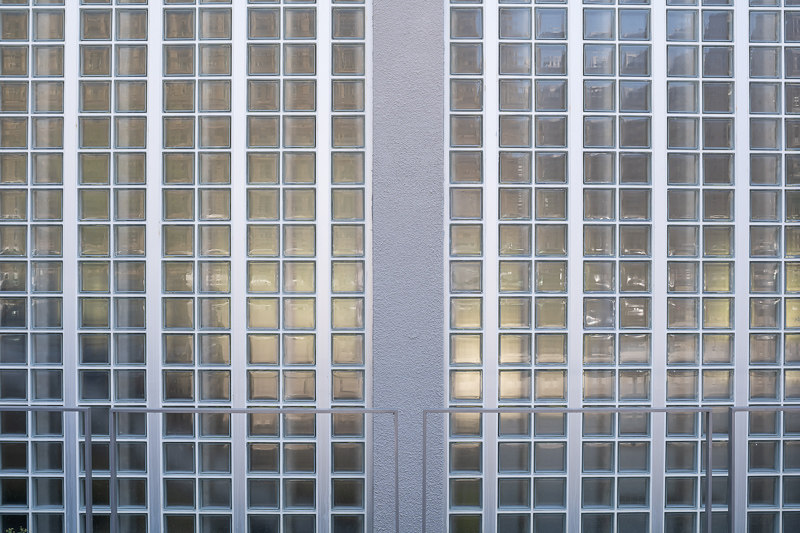
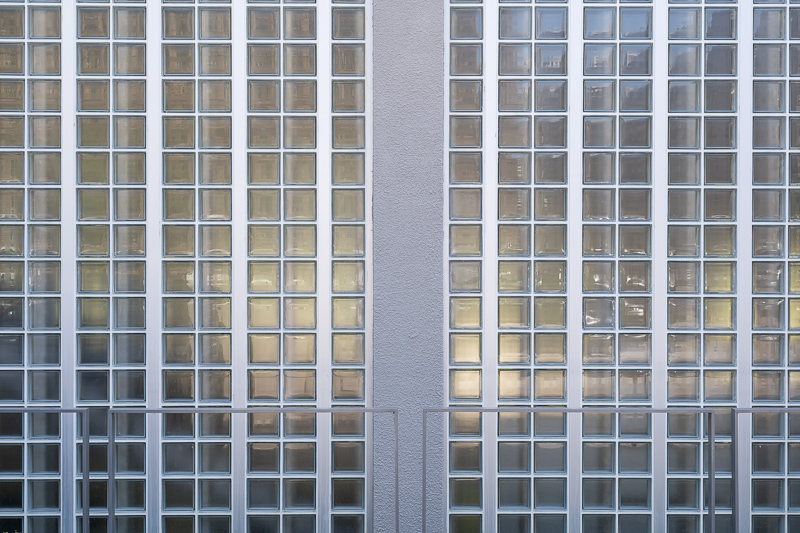
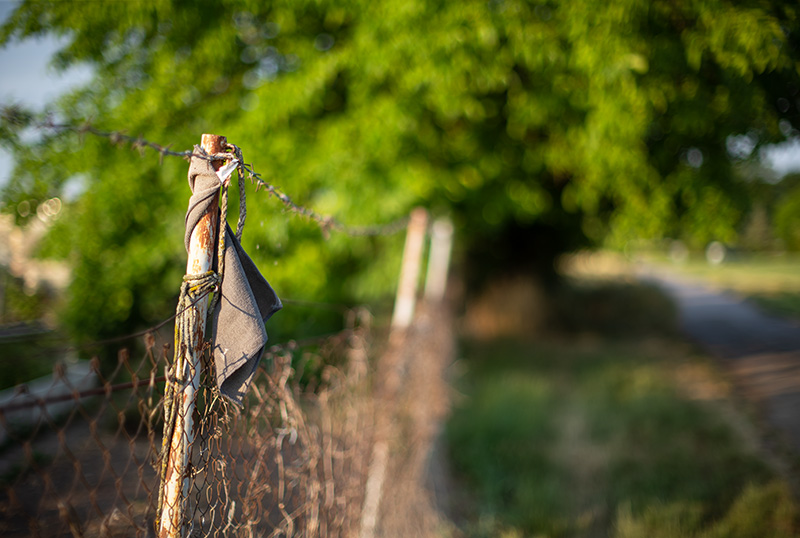
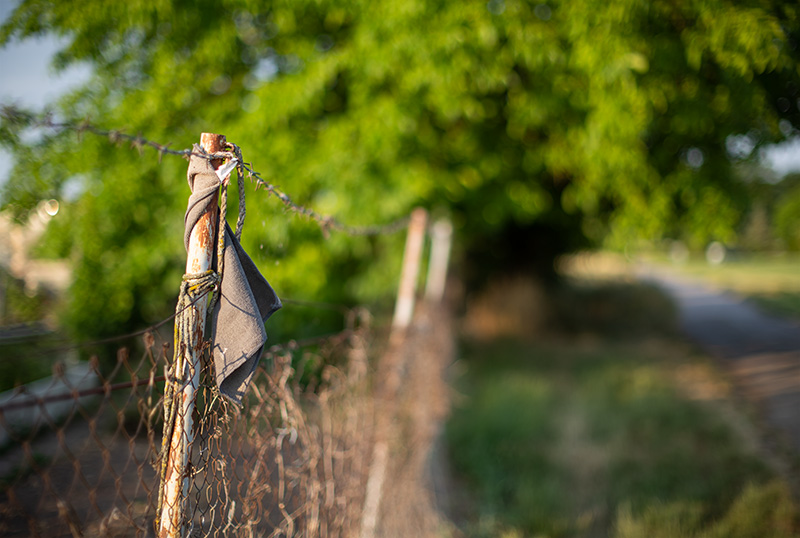
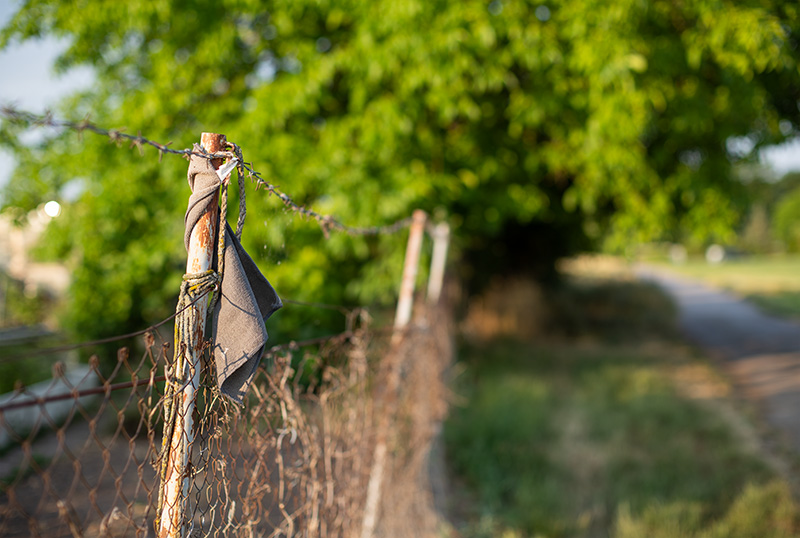

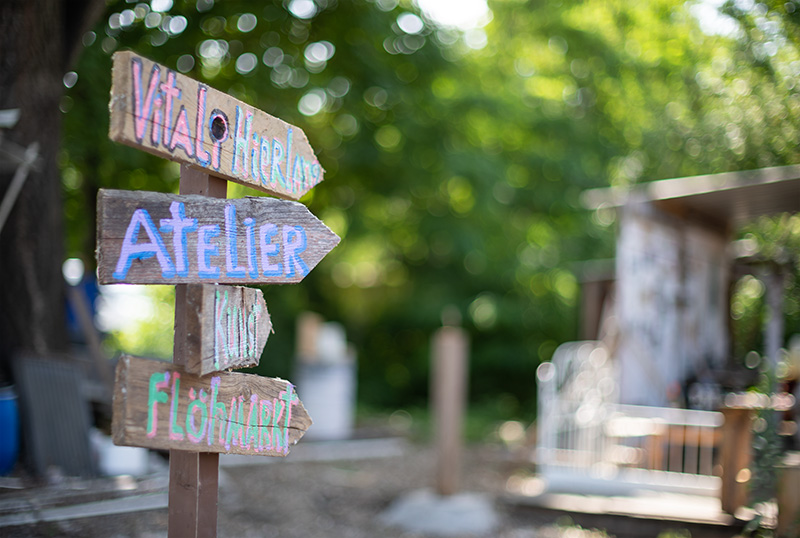

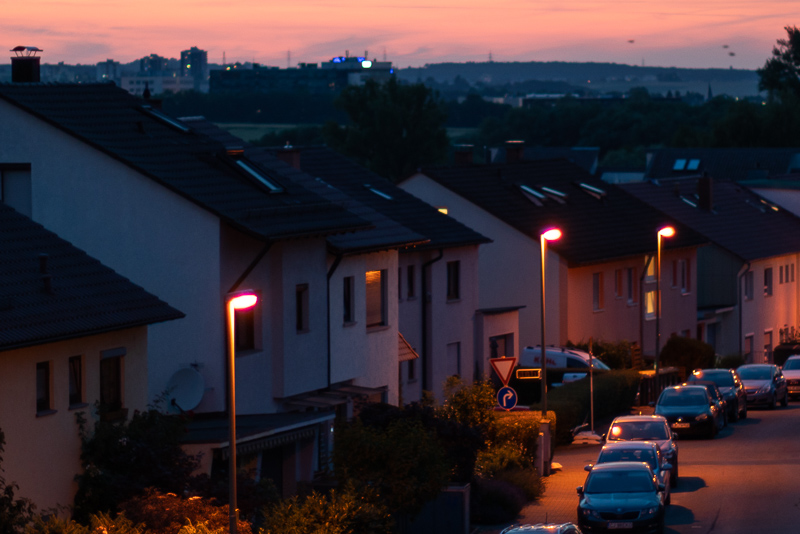
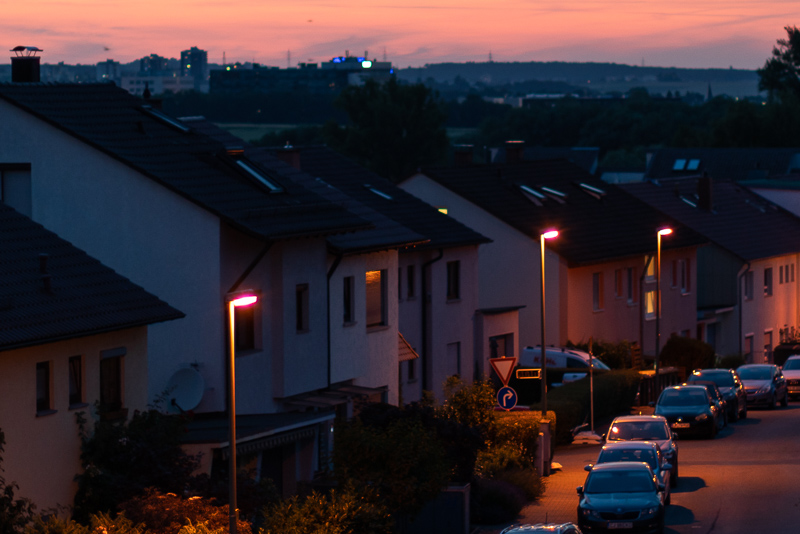
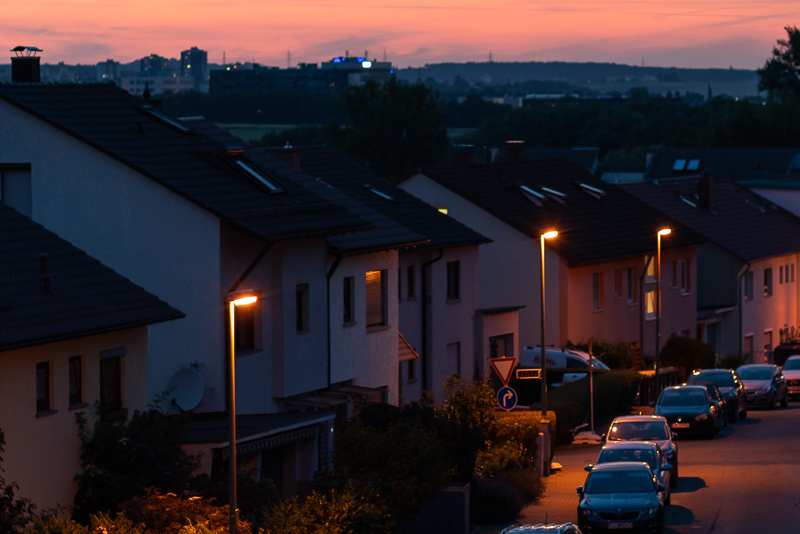
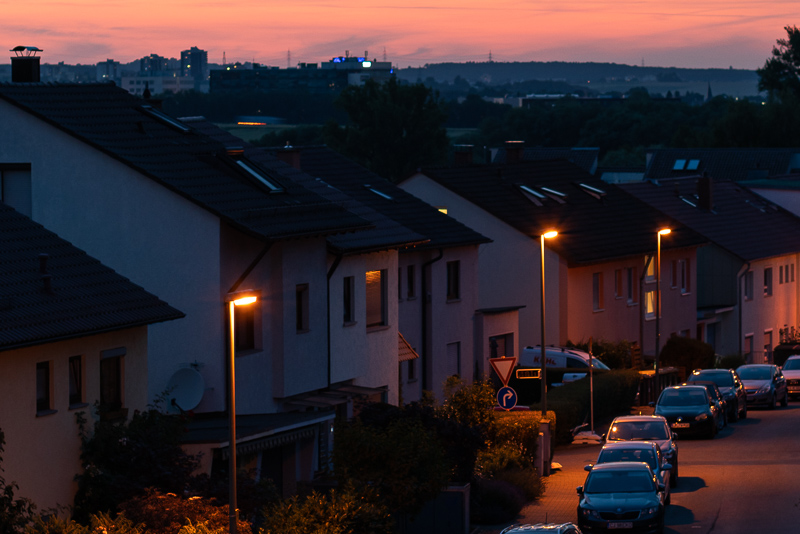
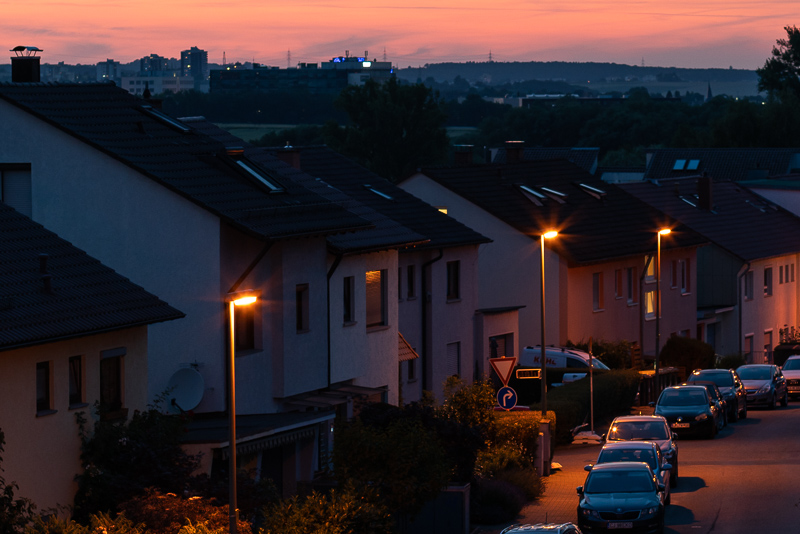

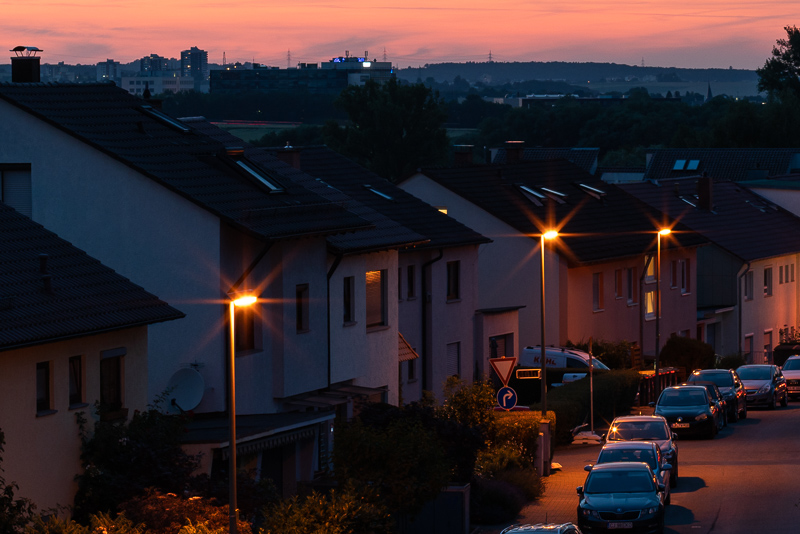

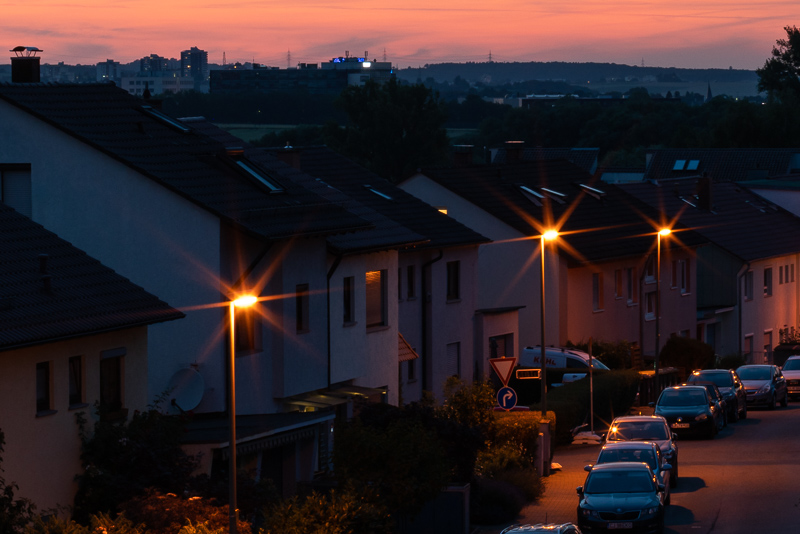
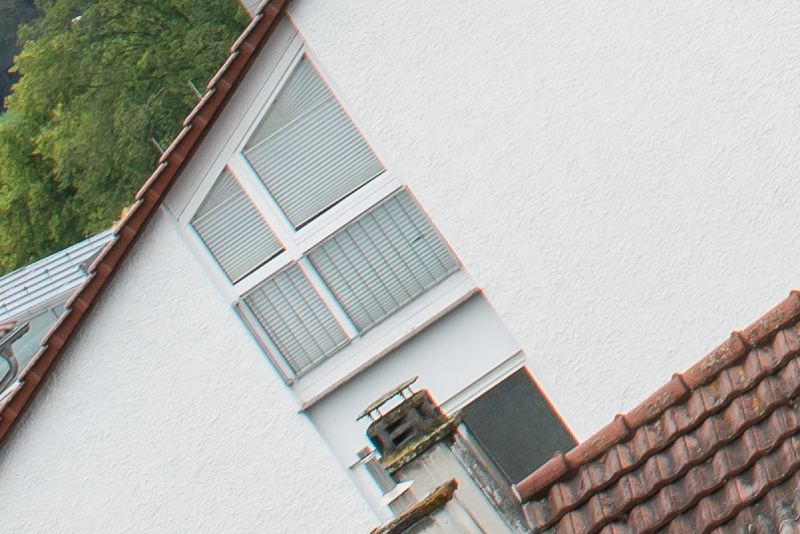
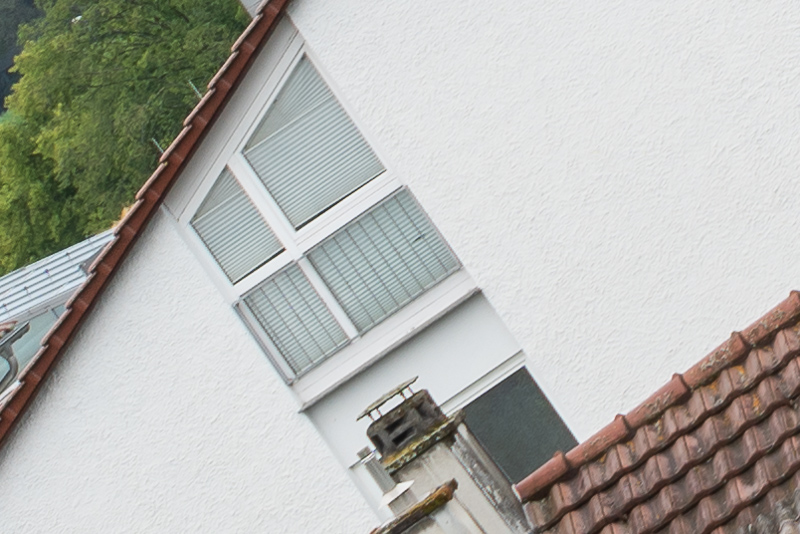
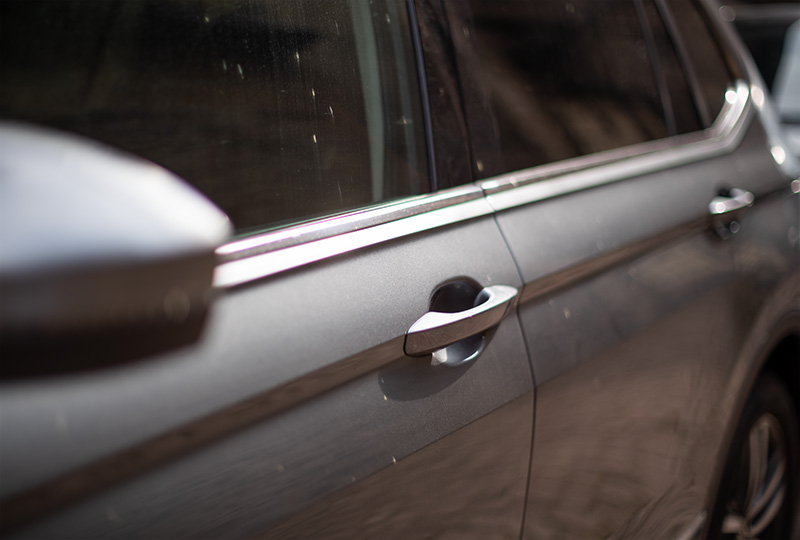
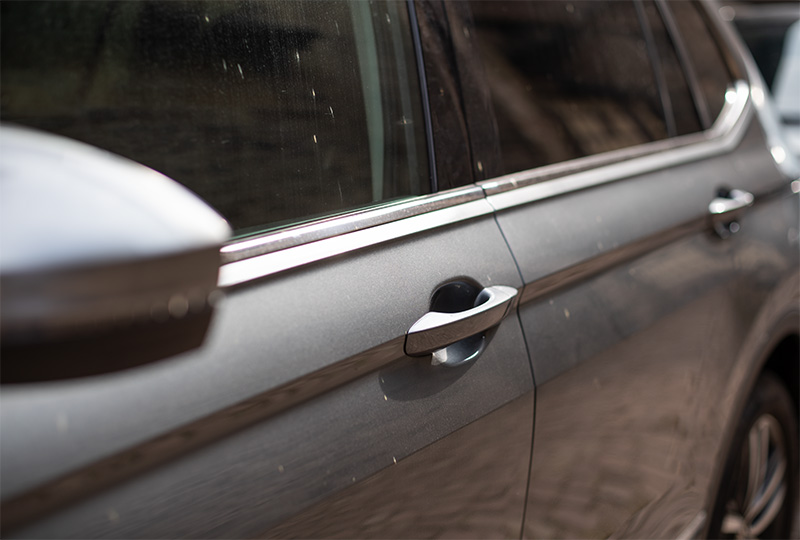
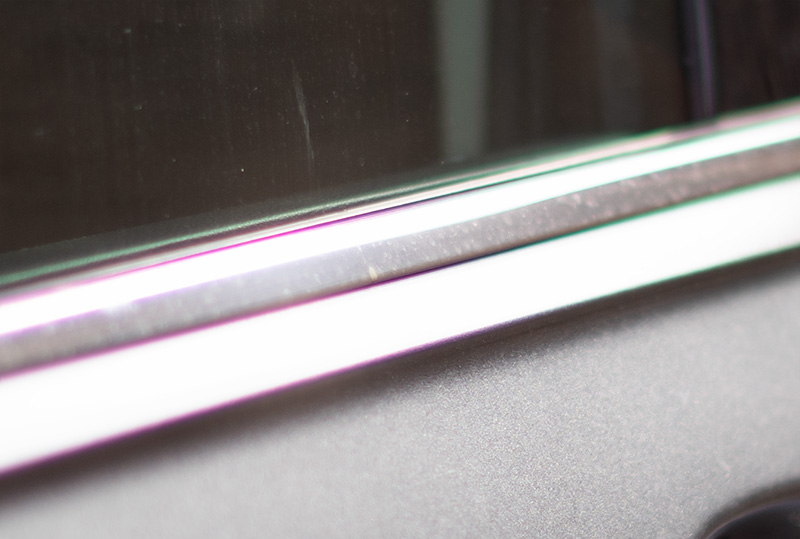
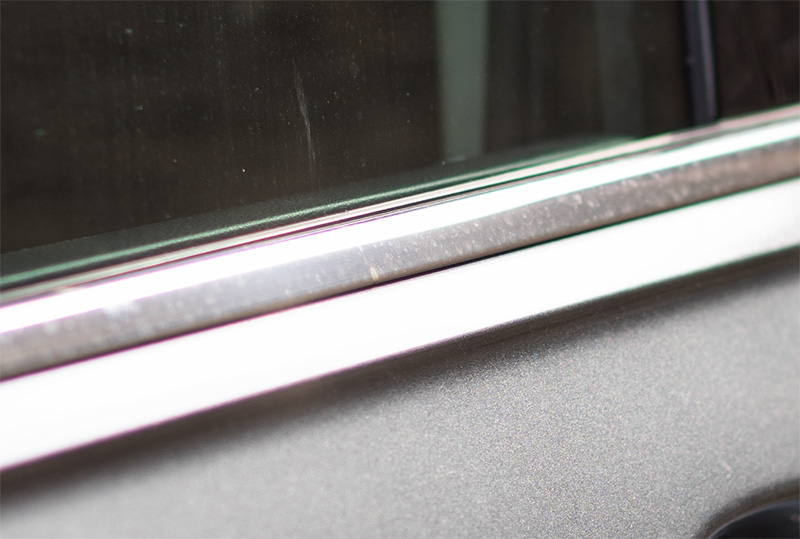

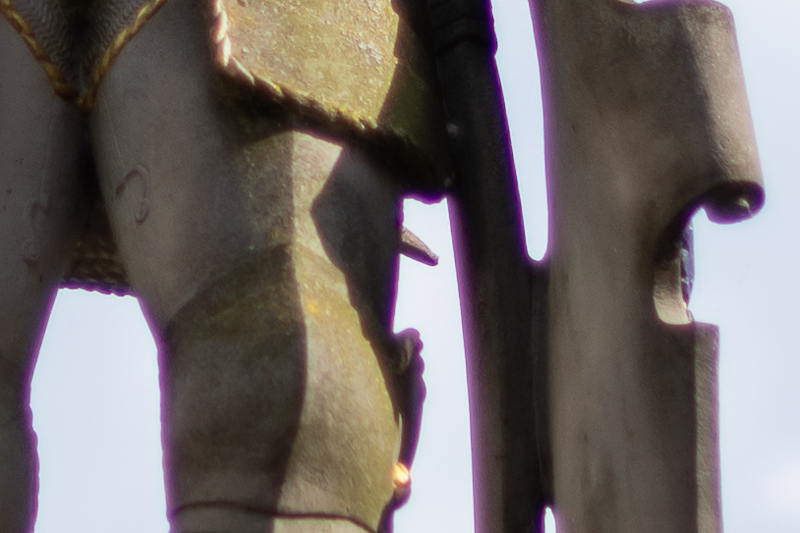
How would you rank this EF vs FD vs LTM? They are all fairly similarly priced these days. I personally see the LTM as the most pleasant rendering, with the EF not far behind. I have no experience with the FD and there’s few reviews for that.
Thanks for the review of this classic and for the reader that made it possible.
I am not sure about that (yet).
The sample of the LTM I had for a review wasn’t in the greatest condition and for my liking it was simply too soft at f/1.2.
I have no personal experience with the FD, but I think I might like that one best.
It has a more complex optical design than the EF so might be sharper across the range at f/1.2.
Just my tiny bit of experience with the FD 55mm 1.2 SCC Silver Nose vs EF 50mm 1.2. The FD mount is a tad sharper then the EF at Infinity, and about the same as the EF at portrait distances. The Bokeh on the FD is much more harsh then the EF mount. for full clarification I’ve used the FD 55mm on Film and MFT digital bodies and the EF 50mm 1.2 on FF EF bodies. I’m quite fond of the 55mm FD lens on an MFT body as a portrait lens. It’s usable wide open but tack sharp by f2 for that use. I’ve used three 50-55mm F1.2 lens and sharpness ranked from best to worst is FD 55mm 1.2 SCC, Canon EF 50mm F1.2, then in last place is the Olympus 55mm F1.2. Hope this helps a bit. Thanks!
Bokeh(Spherical Aberration) can be influenced with cover glass, adapted to FE system can make the bokeh more basy. However, EF 50mm F1.2 L USM only have good bokeh in the center, based on the patent. https://zhuanlan.zhihu.com/p/622238120
Thanks for reviewing this lens, I was a pleasantly surprised to see you reviewing an SLR lens. I wonder if you plan to reviewing more slr lenses? Sometimes I find they render more beautifully than mirrorless lenses and for cheaper. If price doesn’t matter, I actually find the Meike 50/1.2 to be a better option. If not, a slower vintage 50mm option like the Nikon ai-s 50/1.4. if price doesn’t matter, I think the Voigtlander 50/1.2 SE is the best lens in terms of beautiful rendition and especially for the size
Not on a bigger scale. There are a few select ones I would be interested in, but it is unlikely you will see me reviewing things like a Canon EF 50mm 1.8II or a Nikon AF-D 85mm 1.8.
Hmmm what about say this Zeiss Zf/Ze lenses like the 85/1.4, 50/1.4, 35/2 or the A mount Minolta 85/1.4? Or maybe voigtlander SL lenses. Are these possible considerations?
These Minolta AF lenses not so much, the others maybe yes 🙂
Those ZE lens are controversal. I am looking for your reviews on them.
Thank you for this review! I’d considered this lens a couple of years ago for using on Sony. Since then the Techart LM-EA9 adapter was released, and, to my taste, it flopped the entire market of adapted AF lenses. Now it’s possible to hand-pick some really unique glass (often at bargain price), which will give much more satisfaction than just an old DSLR-era lens.
“The Canon EF 50mm 1.2 L USM features the typical Canon L build quality, same as e.g. the Canon EF 135mm 2.0 L USM.”
It does not have the same build quality as 135, the 135 is not weather-sealed, the 50 1.2 is.
I don’t believe in weather sealing of any these lenses, pure marketing gag.
With all due respect, it does not matter what you believe in, what matters are facts only. Ultimately, the build quality of 50mm F1.2 is not the same as that of 135mm F2.0, like you state in the article. It is better, you can see the rubber weather seal around the mount in your photos of the lens too. It might be a consideration for some as using it in light rain should not be a problem, especially with filter attached.
If you really think that rubber gasket makes a difference in light rain I really cannot help you.
Maybe this article could be of interest to you: https://www.lensrentals.com/blog/2019/04/removing-fly-from-weather-sealed-canon-70-200mm/
Hello Bastian,
Really appreciate your work! Is there any chance we see the review of Sony FE 50 1.2 GM? It seems you have experienced it and like it.
I am considering replace my 35gm with the 50 1.2 gm, as the bokeh seems much smoother. To be honest, I find the bokeh of 35gm a bit harsh to my taste, at least compare to Voigtlander 35mm 1.2 Nokton E that I’ve used earlier. Really like the rendering of Sigma 35 1.2 based on your sample shots, but the size and weight of 50 1.2 gm is about the limit for me as a main lens.
Thank you!
JaredZ
There will be. I think of publishing it within the next two weeks.
In terms of bokeh I see it being much closer to the 35mm 1.4 GM than the 35mm 1.2 Nokton though, so I am not sure that switch will make you happy 🙂